Physical Address
304 North Cardinal St.
Dorchester Center, MA 02124
Cutaneous infections are very common and can be caused by a wide variety of different organisms. In addition, it is not uncommon to find involvement of more than one infectious agent affecting the skin, particularly in immunocompromised individuals. Following the onset of both the widespread practice of allogeneic bone marrow and solid organ transplantation, as well as the human immunodeficiency virus (HIV) epidemic, more and more patients are becoming profoundly immunocompromised and thus afflicted by many novel and long-forgotten resurgent infection agents. In addition, the nefarious combination of environmental degradation of native forests with proliferation of disease vectors together with a sharp increase of global travel have produced rapid dissemination of infectious agents, particularly viral. These phenomena often pose major challenges both in the diagnostic and therapeutic aspects of infectious disease management.
Clearly, a book chapter on cutaneous infectious diseases cannot be simply a descriptive iteration of a disease, its clinical features, and pathogenic agents but must also illuminate the significance of the infectious agents in the pathogenic hierarchy of the host organism, as well as the host's response to assault by microbes.
The approach to the patient with a suspected infection, no matter how trivial it may seem, must be a multifaceted one and requires a complete history (including travel history) and physical examination. The possibility of an underlying condition and/or medication that may exacerbate or lead to increased susceptibility to infections must be investigated; one example being a patient with undiscovered diabetes presenting with persistent folliculitis. Much less obvious are individuals taking one of the newer antipsoriasis biologic medications that suppress cellular immunity and predispose to infections by intracellular and fungal organisms. After this background work has been performed, one can begin to make a clinical diagnosis and go on to work up the infection.
After an appropriate inquiry and examination has taken place and an infection is established, the next step is organism identification. Histopathologically, pathogens can by identified by their morphologic features on routine hematoxylin and eosin (H&E) stain, and one can always resort to a variety of histochemical and immunohistochemical stains that can help to highlight the organisms. Among the histochemical stains most heavily used in the diagnosis of infectious agents of the skin are the modified Brown-Hopps tissue Gram stain for bacteria, the periodic acid–Schiff (PAS) as well as the silver impregnation-based stains (Grocott-Gomori methenamine silver [GMS]) for fungi, and finally the Ziehl-Nielsen and Fite preparations, used for mycobacteria. As far as the immunohistochemical stains are concerned, the majority of the available antibodies are directed towards viral agents, such as the ones in the herpesvirus group. However, antibodies have been developed for other infectious agents, such as the ones in the Leishmania spp. group.
It is important to remember that when one evaluates the skin for infectious agents, the resident normal flora of the skin should be taken into account. For example, in the pilosebaceous unit, one can find not only Demodex folliculorum mites but also yeast forms of Pityrosporum ovale , gram-positive cocci and coccobacilli ( Staphylococcus epidermidis and Micrococcus spp.), and corynebacterial organisms ( Corynebacterium spp.). In contrast, the presence of gram-positive cocci outside the follicles in the dermis or fat is always abnormal and can be evidence of a very serious infection, such as cellulitis or even fasciitis.
When evaluating for bacterial infections, one should remember that these could be secondary to another underlying infection or to a noninfectious condition of the skin. As the clinician must also think of underlying causes or other infections, so must the pathologist be aware of how widespread secondary bacterial infections are. For example, a Majocchi granuloma, caused principally by dermatophyte fungi, can become secondarily infected and be mistaken for a bacterial folliculitis. In the scalp, persons with seborrheic dermatitis can develop secondary bacterial infections that render the dermatitis more difficult to treat.
Although histopathology by H&E and histochemical and immunohistochemical stains can be very helpful, the most reliable way to make a definitive diagnosis of a skin infection is by culture. However, culture, by itself, is not always reliable. As stated by Rapini, less than 10% of cultures are positive in infectious cellulitis. Swab cultures should be used only for the most superficial types of bacterial infections, such as impetigo or ecthyma. They are useless in deep infections, such as cellulitis or panniculitis. In these instances the best approach is to culture the tissue directly. Optimally, a biopsy should be taken, with at least half of the specimen saved for routine processing and diagnostic microscopy. The other half should be transported immediately to the laboratory, where it will be appropriately dissected into small pieces and placed on the appropriate culture medium. Mishandling and subsequent desiccation of the tissue ensures a negative culture. If there is a chance of delay in getting tissue to the laboratory, the tissue may be transported on sterile, normal saline–soaked gauze. Touch preparations may be used in special cases, such as in chancroid or granuloma inguinale, entities in which organisms are very infrequently found in tissue-stained samples. In addition, touch preparations are extremely useful in infections with acid-fast organisms. In expert hands, touch preparations of traumatized ear lobe from patients with lepromatous or borderline lepromatous leprosy can yield a very good estimate of the number of mycobacterial organisms. The Fite stain is particularly useful in identifying the Hansen bacillus in tissue sections. When liquid specimens are available, auramine-rhodamine stain preparations under fluorescence microscopy are also useful for mycobacterial identification due to its sensitivity, with the caveat of a lack of specificity. Finally, more recent methods using molecular biologic techniques, such as evaluation of tissue by polymerase chain reaction (PCR)-based assays, 16S ribosomal RNA (rRNA) sequencing, and in situ hybridization (ISH), have proved to be extremely useful, particularly if speciation is needed. Their use is not yet widespread but can be obtained in many instances by contacting the US Centers for Disease Control and Prevention (CDC). Many of the academic centers in the United States are also developing at least the immunohistochemical techniques for identifying organisms.
In this chapter we will attempt to address the main infectious conditions affecting the skin, starting with the most commonly encountered ones, bacterial, viral, and fungal infections, and then moving on to the more unusual entities caused by complex organisms, such as protozoa, helminths, arthropods, and algae.
The overwhelming pattern seen in cutaneous bacterial infections is that of an exuberant neutrophilic infiltrate, often accompanied by debris and a variable amount of microorganisms ( Fig. 20.1 ). According to the location of the neutrophilic collection in relationship to the skin's microanatomy, the lesions are given different names. If the neutrophils are predominantly subcorneal, they are designated as subcorneal abscesses, the most common cause of which is impetigo. When they coalesce in abscesses that replace the epidermis, the lesion is called ecthyma. Dermal neutrophilic infiltrates and abscess are called cellulitis; in the panniculus, a suppurative reaction or panniculitis; and in the fascia, neutrophilic, suppurative, or necrotizing fasciitis, depending on the extent and the clinical presentation.
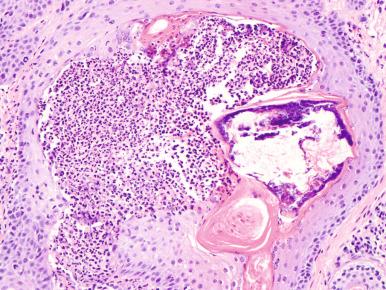
As neutrophilic infections become more chronic, they exhibit plasma cells. Very rarely do infections, except for syphilis and other treponemal infections, cause a predominantly plasma cell infiltrate. Infiltrates may be superficial and deep, involving vessels with prominent endothelial swelling and showing perineural inflammation. Only a few bacteria are associated with lymphocytes, the principal one being the agent of Lyme disease. There are admixed plasma cells with this infiltrate, which is also superficial and deep and can show involvement of nerves. In addition, one must always remember that 40% of early secondary lues is associated with lymphocytes.
Some bacteria induce the formation of granulomas, Mycobacterium tuberculosis being an excellent example. However, M. tuberculosis infection begins as a neutrophilic cellulitis that goes on gradually to be infiltrated by lymphocytes and finally by monocyte-macrophages that form a granuloma, resulting from a type IV hypersensitivity response.
The following sections will be devoted to describing cutaneous infections produced by specific group of bacteria. We will start with the diseases produced by gram-positive organisms, followed by the ones caused by gram-negative, mycobacteria, treponemal, and the bartonelloses. We will then finalize the bacterial infection segment with the intracellular rickettsial and chlamydial organisms as a transition to the next section, the viral infections.
Impetigo affects mainly children, commonly around the mouth, nose, and groin, often after trauma. The lesions occur acutely. They are most commonly crusted and have been described as exhibiting a honey-colored crust. There is a bullous form in which lesions 1 to 2 cm in size appear, especially below the nose and in the groin and upper thighs. These lesions are not pustular but are clearly bullous. Impetigo frequently occurs in a setting of other dermatoses. For example, eczematous dermatitis commonly becomes infected, especially when weeping begins. The previously mentioned honey-colored crusts are the hallmark of this complication.
The acute lesion consists of a subcorneal blister in which there are varying numbers of neutrophils (see Fig. 20.1 ). Independently of the presence or absence of a bulla, lesions of impetigo tend to harbor a variable amount of acantholytic cells. The diagnosis of pemphigus foliaceus must be excluded in cases in which these acantholytic cells are particularly abundant in the superficial layers of the epidermis ( Fig. 20.2A ). A tissue Gram stain can demonstrate the presence of organisms, confirming the diagnosis of impetigo (see Fig. 20.2B ). However, if doubt persists, immunofluorescence studies may be necessary to rule out pemphigus foliaceus. If there has been a preceding eczematous response, the eczematized tissue will reveal a prominent scale crust. Spongiform pustules are very infrequent in lesions of impetigo lesions. Rather, the neutrophilic infiltrate is disposed in a scattered fashion below the crusted area. This feature helps to distinguish it from pustular psoriasis.
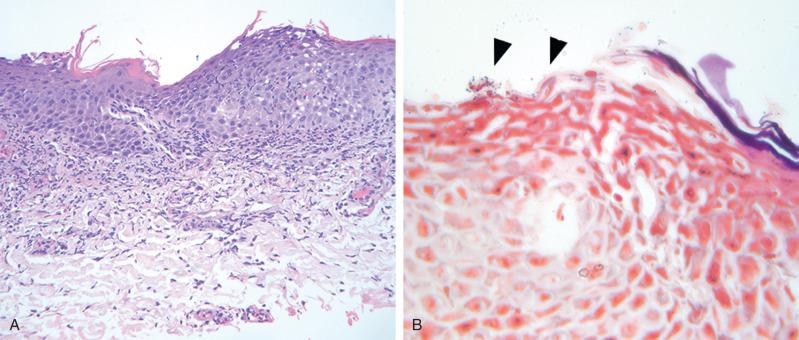
The etiology of impetigo includes, in many instances, prior trauma. Poor hygiene in children, hot and humid weather, and occlusive clothing with sweating all appear to contribute to the process. In adults, it can very often be seen arising associated with a disruption of the epidermis due to nonmelanoma skin cancers (NMSCs), such as squamous and basal cell carcinomas. The organisms most commonly involved are Staphylococcus aureus and Streptococcus pyogenes . Either of these agents can cause the lesion, but the overwhelming majority of the bullous form of impetigo is related with S. aureus , particularly with the strains belonging to the group II and phage type 71. Strains that have been proven to elaborate the A and B types of exfoliative toxins often result in lesions with prominent acantholysis and subcorneal bulla formation. These toxins act on desmoglein 1, which is the target of antibodies in pemphigus foliaceus, rather than desmoglein 3. The streptococcal-induced forms of impetigo have been associated with glomerulonephritis in rare instances, approximately 5%, particularly the serotypes 1, 4, 12, 25, and 49. For this reason, many clinicians treat impetigo with oral antibiotics in addition to topical care.
The staphylococcal scalded skin syndrome (SSSS), also known as Ritter disease (not to be confused with Ritter syndrome), is a potentially serious complication of staphylococcal infections leading to generalized blistering and desquamation accompanied by systemic symptoms. Small children, mainly younger than 5 years of age and even neonates, are among the most often afflicted by SSSS. This disorder usually begins with the appearance of bright red skin around the head and neck, which most commonly goes on to blister. The bright erythema of the head and neck gradually spreads to the trunk, axillae, groin, and then extremities. The source of infection is usually occult; conjunctivitis, groin or nostril infection, or even gastrointestinal or urinary tract infection may be the origin. Patients develop constitutional symptoms as the lesions progress. Mortality in children is usually low, except in neonates. In adults, mortality can be as high as 60%, and the disorder is often associated with kidney failure or other debilitating illness. Adults with SSSS present clinically with desquamation of the skin, not blistering. SSSS differs from a disease called staphylococcal scarlet fever, in which there is severe desquamation without blistering. The latter disorder also has circulating enterotoxins and may represent a form of toxic shock syndrome (TSS), discussed later. The major differential diagnostic consideration is toxic epidermal necrolysis (TEN). In this disorder, there is sloughing of the skin due to full-thickness necrosis of the epidermis involving the entire skin and the oral, conjunctival, and genital mucosal surfaces.
The pathologic changes of SSSS are minimal but distinctive. The cleft is seen between the granular layer and the stratum corneum; at the floor of the blister, there is a very regular, smooth surface of keratinocytes that is associated with variable acantholysis. There is no hint of dyskeratosis to suggest pemphigus foliaceus. Because toxins secreted at a distant site mediate SSSS, inflammation is scant to nonexistent and bacterial forms are not seen, in contrast to bullous impetigo, in which the same toxins are secreted and act locally (“localized form of SSSS”). As mentioned before, TEN is the major differential diagnosis. Rapid diagnosis using frozen section is usually helpful to distinguish SSSS from TEN. One need only take a Q-tip and roll up the sloughed skin. In SSSS, one sees only stratum corneum with a rare keratinocyte, as opposed to the full-thickness necrotic skin observed in TEN. The presence of lymphoid inflammation and a subepidermal bulla favor TEN.
This disorder is caused by the production of the epidermolytic exfoliative toxins A or B and is frequently and mainly associated with a specific strain of S. aureus , namely the phage type II group, especially type 71. As mentioned previously in the bullous impetigo section, these toxins target desmoglein 1, the same antigen targeted by autoantibodies in bullous impetigo and in pemphigus foliaceus. Because the kidneys in children do not appropriately excrete SSSS toxins until they mature, the damage done by them is greatly potentiated. In adults, there must be at least some impairment of kidney function or other debilitating disease that impedes release of the toxin.
TSS is clinically characterized by prominent high fever, systemic symptoms, and a very diffuse eruption composed of brightly erythematous patches resembling sunburn. This generalized erythrodermic rash subsequently exfoliates often with marked desquamation of the palms and soles. The patient also experiences nausea with vomiting and diarrhea, headache, and possibly vertigo. Marked hypotension is usually present as another indication of multiple system involvement. Toxins secreted by S. aureus are implicated in the overwhelming majority of TSS cases. However, toxins derived from S. pyogenes may cause a small fraction of TSS cases, which are denominated streptococcal TSS (STSS) or toxic shock–like syndrome (TSLS). The CDC has defined a set of clinical criteria for staphylococcal TSS that include the following: (1) body temperature greater than 38.9°C (102.02 F), (2) hypotension (systolic blood pressure <90 mm Hg), (3) diffuse macular erythroderma, (4) desquamation of skin (including palms and soles) 1 to 2 weeks after onset, and (5) involvement of three or more organ systems. In addition, a laboratory criterion (6) represented by a lack of positive cultures for other bacteria/organisms other than S. aureus is required. A confirmed case will have all six criteria (including the laboratory criterion), whereas a probable case will show the laboratory criterion together with the five or four of the clinical criteria.
Microscopic skin changes found in TSS vary and include, at first, a mild, spongiotic reaction, with intraepidermal lymphocytes and neutrophils overlying dermal edema, and a perivenular lymphoid infiltrate with scattered neutrophils and red blood cells. The presence of a few aggregates of neutrophils in the epidermis, with dyskeratotic cells, may indicate TSS as the correct diagnosis. In the most florid reaction, there is a pustular vasculitis, with a neutrophilic abscess in the subcorneal space, in the epidermis, beneath the epidermis, or in the follicular orifice of the sweat glands. In addition, in the dermis, either necrotizing vasculitis with focal fibrinoid necrosis of vessels or a Sweet-like reaction may take place. The latter exhibits endothelial cell swelling and a perivascular lymphocytic infiltrate admixed with occasional neutrophils and eosinophils. There is no evidence of fibrinoid necrosis, but there is definite extravasation of red blood cells. These findings are not entirely specific for TSS because pustular vasculitis may be seen in other septic conditions, including deep fungal infections, connective tissue diseases, and Behçet disease. Drug eruptions can also manifest with similar histologic changes.
This syndrome was first described in association with superabsorbent tampon use and was related to the causative organisms growing in the vagina in the medium created by the tampon and proteinaceous menstruum. Fortunately, after discontinuation of these types of tampons by the manufacturers, a sharp decrease in tampon-related TSS cases was observed. However, to date, a significant number of TSS cases have been associated with other infections, including abscesses, wound infections, and other systemic infections.
The staphylococcal-derived exotoxins that can cause TSS are definitely different from the one that causes SSSS and are represented by type B enterotoxin and toxic shock syndrome toxin 1 (TSST-1). In cases of STSS/TSLS the toxins secreted by S. pyogenes organisms are the phage-encoded Streptococcal pyrogenic exotoxins SpeA and SpeC. These toxins are clear examples of the so-called superantigens. These protein-based antigens strongly interact with T lymphocytes expressing the variable portion of the β chain (Vβ) in their T-cell receptor (TCR) molecules. This persistent stimulation results in a marked expansion of this particular subset of T cells that trigger a massive cytokine release, mainly from macrophages. Particularly noteworthy is the abundant secretion of interleukin-1 (IL-1) and IL-2 and tumor necrosis factor (TNF), two well-known mediators of shock. This uncontrolled “cytokine storm” results in TSS and also explains why the therapeutic approach using intravenous immunoglobulin G (IgG) therapy is quite successful in some cases.
Ecthyma is a localized bacterial cutaneous infection that, like impetigo, favors children and can similarly affect the occlusive areas of the body. It often appears as a well-demarcated crusted ulcer filled with purulent material in the lower limbs. Ecthyma resembles any type of inflamed, infected skin lesion with crusting. Culture is the best manner of diagnosing the exact cause of the lesion.
The lesion usually has a sharply demarcated border in which aggregates of neutrophils are present in the center of the lesion and diffusely throughout the superficial dermis. There is frequently a neutrophil-impregnated crust ( Fig. 20.3 ). Bacteria can often be visualized using tissue Gram stain.
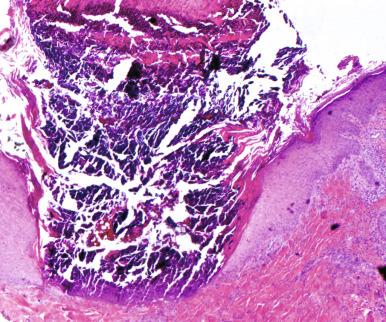
Ecthyma has features similar to those of impetigo as far as the organisms and pathogenesis are concerned. However, one of the causative organisms is usually S. pyogenes . Often, culture reveals mixed staphylococcal and streptococcal infections. It is important to mention that the term “ecthyma,” from the Greek εκθύω “break out,” which literally means “break out in a rush” and in this case will be of purulent material, is used in several other types of lesions produced from a variety of organisms, such as parapoxvirus in ecthyma contagiosum (also known as orf). Among bacterial-related ecthymas, there is significant overlap between ecthyma and ecthyma gangrenosum (discussed previously), both likely representing a cutaneous infection reaction pattern. Some authors propose unifying both concepts under the “ecthyma gangrenosum” rubric. Nevertheless, the lesions referred to as ecthyma gangrenosum often reflect a more serious condition (see later).
This lesion begins with a red macule or papule and progresses rapidly to a pustule or bulla in a very sick, often immunosuppressed patient. It then progresses to become a bulla and/or directly ulcerates, with formation of a black eschar. In some patients, multiple lesions develop. These patients usually have an underlying mild coagulopathy that sets the stage for the thrombotic septic changes that occur. The lesional history is characteristic, with lesions appearing in 12 hours or less. The eschar or crust has been classically referred to as “sphacelus.” The history and physical features are classic and are considered to portend a serious prognosis unless treated adequately and promptly.
The histologic changes are quite characteristic in the classic case. They include an ulcerated, necrotic epidermis with a fibrin-laden base filled with debris overlying a pauci-inflammatory vasculopathy or vasculitis with minimal perivascular neutrophils and sometimes lymphocytes. In addition, one may see clusters of gram-negative rods in the vessel wall and surrounding the vessels. The principal differential is indicated by the presence of a fungal organism, such as Zygomycetes spp . , that can also cause necrosis and vasculitis. Appropriate stains aid in diagnosis.
The lesion usually appears in severely debilitated or immunosuppressed patients who are septic. Although the offending organism in the classic case is Pseudomonas aeruginosa , various other organisms have been implicated.
The infection known as erysipelas (from the Greek ἐρυσίπελας “red skin”) was already recognized as a clinical entity back in the times of the ancient Greeks. Characteristically, erysipelas often affects the face and manifests rapidly as an area of swelling that is hot and bright red and shows well-demarcated advancing borders. Lymphangitis and lymphadenitis can often be found, and in some lesions the swelling is so marked that blisters or bullae appear. It is occasionally associated with marked systemic symptoms of malaise, fever, vomiting, and high fevers. Cultures are only rarely positive. Detection of elevated antistreptolysin O or anti-DNAase B in the patient's serum is useful; however, the clinical symptomatology is so striking and characteristic. Prompt treatment is necessary because a small percentage of patients develop bacteremia. Erysipelas can be recurrent and associated with diabetes. Other diseases, such as a severe contact dermatitis, photoallergy, or even lupus erythematosus, may resemble this infection, but the lesions of erysipelas have a more specific distribution pattern; in contrast to contact dermatitis or photoallergy, patients usually lack severe fever and constitutional symptoms.
This lesion is a classic example of severe cellulitis. There is marked edema in all compartments of the skin ( Fig. 20.4 ). At the least, there is epidermal intercellular edema, but, in more severe cases, subepidermal bullae can appear. The papillary and reticular dermal fibers are markedly separated and, due to fibrin exudation, may have a more bluish, less refractory character. Lymphatics are dilated. There is also edema of the subcutis, with small zones of fat necrosis caused by a relative ischemia. Scattered throughout the edematous areas are neutrophils and neutrophilic debris. There is no particular perivascular localization. Bacteria are difficult to observe in this lesion. In other types of cellulitis, bacteria may be easily demonstrable with Gram staining, especially in the presence of immunosuppression.
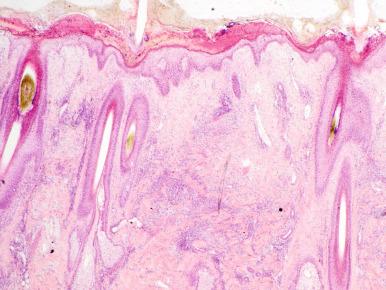
The classic implicated organism is S. pyogenes (group A streptococcus [GAS]). Less frequently, other streptococci and even S. aureus can develop a similar lesion. Several toxins produced by the streptococci, possibly including hyaluronidase, streptolysin, and other exotoxins, are likely implicated in the production of this lesion.
Erysipeloid, also known as Rosenbach disease, was so named because it clinically resembles erysipelas, with prominent edema and a well-demarcated border. However, it is less severe and affects mainly the fingers by inoculation via finger microtrauma. Erysipeloid is an occupational disease and primarily affects fishermen and persons who handle fish or other animal tissues, such as raw meat. Two main clinical presentations related are described: a cutaneous infection, which can be localized or generalized, and a septicemic one. The localized cutaneous infection (erysipeloid) is the overwhelmingly more common one seen in humans. The first manifestation of erysipeloid is usually a bluish or erythematous macule at the site of inoculation. As the lesion gradually and slowly increases in size, it develops well-defined and raised borders and there is a tendency to develop a central area of clearing. The affected area, usually the fingers, tends to develop notorious edema (“bubble finger”). In contrast to erysipelas, constitutional symptoms are seldom encountered in the localized cutaneous form. However, in the extremely rare generalized cutaneous form constitutional symptoms are the rule. Other types of cellulitis may resemble this infection on the hands, especially those caused by staphylococcal and streptococcal organisms. Brucellosis also affects the hands of persons who are in contact with animal tissues, but it is clinically different, with multiple papules and pustules. Anthrax and tularemia both ulcerate. Because other organisms can cause hand infections, culture of the tissue is imperative.
The changes of the erysipeloid lesion include marked papillary dermal edema with scattered neutrophils infiltrating between the collagen bundles. In this disorder, lymphocytes and plasma cells can be frequently observed. Occasional eosinophils are visualized. Lymphatics are dilated. In most cases, there is no vasculitis and no perivascular prominence of the infiltrate. While the overall changes are much less severe than in erysipelas, lesions exhibiting marker changes, including epidermal necrosis and involvement of the subcutaneous adipose tissue can be seen in immunocompromised patients. The organisms are very difficult, if not impossible, to recognize in tissue with Gram stain.
The causative organism Erysipelothrix rhusiopathiae can be found as a commensal or pathogenic organism in a variety of animals but principally in swine and fish. Cultures of E. rhusiopathiae can resemble other gram-positive infections, so it is important to communicate the suspected diagnosis to the laboratory personnel. Although culture can lead to identification of the organism, PCR assays have been successfully used to identify this pathogen.
Cellulitis is a general term that refers to an inflammation of the skin that manifests as a red, brightly erythematous macule or plaque or as an indurated nodule or plaque that is warm and usually tender. Thus it qualifies for the ancient definition of infection: tumor , dolor , calor , and rubor . As the lesions become more chronic, scaling, bullae, and even ulceration may appear. Lymphangitis and even lymphadenopathy are sometimes present. The most common causative organisms in the immunocompetent patient are S. aureus and GAS. In the immunosuppressed patient, there are many other possible causative organisms. A distinctive type of perianal cellulitis that exhibits the characteristic features of cellulitis is termed perianal streptococcal “dermatitis” or “cellulitis.”
The previous description of cellulitis summarizes the findings. There is diffuse dermal and subcuticular edema with a diffuse infiltrate of neutrophils. Depending on the degree of edema, there can be vascular ectasia with extravasation of red blood cells. Dilated lymphatics are also observed and are a clue to the nature of the process. Organisms are almost impossible to observe, even with appropriate stains. In the more chronic lesions, the epidermis may show spongiosis with intraepidermal vesicles and even ulceration and necrosis. Likewise, intraepidermal pustules may be noted. In extensive disease, neutrophil-rich areas may give the appearance of vasculitis; such vascular involvement is considered secondary to the cellulitis. In very chronic lesions, fibrosis may also be noted in reaction to the zones of necrosis. Culture of tissue is necessary to identify the organisms. In cases of marked cellulitis with neutrophils, the question of neutrophilic dermatoses is raised. The latter lesions differ by their clinical presentation, often by the patterns of neutrophilic infiltration, and by negativity of tissue cultures.
As indicated earlier, the most common causes of cellulitis are S. aureus and GAS. However, in the immunosuppressed patient, one may find acid-fast organisms, fungi, and a variety of bacteria, including Klebsiella spp., Proteus spp., Clostridium spp., as well as fungi, such as cryptococcal organisms and other yeasts, and even amebas. The pathologist must be aware of the possibility of finding these many diverse organisms. Immunosuppressed patients may have multiple infections, presenting a challenge to pathologist and clinician. One type of cellulitis that should be emphasized is the facial or periorbital cellulitis that is caused by encapsulated forms of Haemophilus influenzae type B. This infection occurs in the first years of life.
Necrotizing fasciitis is an often extremely destructive infection that occurs acutely in the fascia and the soft tissues, with a very rapid course, resulting in extensive necrosis of the tissue. It usually occurs in a background of peripheral vascular disease, diabetes, chronic alcoholism, or drug abuse but can occur spontaneously in otherwise healthy young patients. There is often a history of injury.
Three types of necrotizing fasciitis have been described. Type I is a mixed infection. Type II is caused by either S. aureus or GAS. Type III is the most destructive type and often occurs after an injury or puncture wound. Its cause is the Vibrio group of organisms, such as Vibrio vulnificans . Because these infections are all so virulent, intense antibiotic therapy and radical surgical débridement are often necessary to save the life of the patient. The lesions manifest clinically as rapidly progressive, painful areas of marked induration and erythema. Blisters and ulceration develop quickly with the extensive necrosis. The mortality rate is approximately 50%.
In contrast to cellulitis, this process involves the dermis and subcutis, but the areas exhibiting the most severe changes are the fascia and deep soft tissues, where extensive hemorrhage, necrosis, thrombosis, and secondary vasculitis are observed. Evaluation of the extent of disease using frozen section analysis has been found to be useful by some groups.
As stated previously, numerous organisms in addition to S. aureus and GAS can cause necrotizing fasciitis. These include Proteus spp. and, very importantly, anaerobes such as the clostridial organisms, Bacteroides spp., Peptostreptococcus spp., and the marine group of Vibrio spp.
Pyoderma vegetans is basically a reaction pattern to a variety of bacterial organisms that mimics fungal infection presenting in immunocompromised individuals. However, it can occasionally present in immunocompetent persons. This disorder manifests clinically as one or more verrucous plaques that are studded with pustules and exhibit sinus tracts. The most common sites of involvement are the axillae and groin and the lower extremities. There is a facial variant that can be markedly disfiguring. To make a definitive diagnosis of pyoderma vegetans, one should rule out a fungal infection (negative culture and serology) and exposure to bromide or iodide and have a positive culture for one of the known bacteria causing the disorder.
Marked pseudoepitheliomatous hyperplasia associated with hyperkeratosis and parakeratosis and multiple intraepidermal abscesses characterize this disorder. There are also dermal abscesses. A perivenular infiltrate of lymphocytes, histiocytes, neutrophils, and occasional eosinophils is present. Scattered granulomas may also be observed.
There are two important differential diagnoses: deep fungal infection and pemphigus vegetans. A deep fungal infection will usually demonstrate readily identifiable fungal structures, either by H&E and/or by fungal histochemical stains. Pemphigus vegetans exhibits histologically unequivocal acantholysis and suprabasilar clefting, along with intraepidermal and papillary dermal collections of eosinophils.
The most common infectious cause of this disorder is considered to be S. aureus , although a few other causative bacteria have been described. It also occurs as a variant of pyoderma gangrenosum associated with inflammatory bowel disease.
The causative organism of anthrax is the gram-positive, spore-forming rod Bacillus anthracis. The incidence of anthrax is low in the United States, but in some parts of the world the disease is much more common. Although infections by this agent are more prevalent in animals and human infection has been long considered an occupational disease, in the first decade of the 21st century this agent has been the focus of interest due to its status as a category A bioterrorism weapon and prior use as such in the early 2000s. There are three essential forms of infection: cutaneous, inhalational, and gastrointestinal, with the cutaneous form being the most common and less severe variant. The inhalational form leads to the most serious form of infection and is the one exploited by bioterrorism. The gastrointestinal form can occur after ingestion of contaminated meat. Following the sharp increase in intravenous drug abusers (IVDAs) that occurred from 1999 to 2011, a fourth form of infection, injectional, has been described related to contaminated heroin.
Because the spread is carried out by direct contact of the spores with skin abrasions, the exposed skin is characteristically involved. In adults the lesion is more common on the hands due to direct contact with spores carried by infected animals, such as rabbits, goats, and sheep. In children the head and neck area is the most frequently involved site, likely from environmental contamination of prior wounds. The initial lesion arises after an incubation period of 1 to 10 days as a red macule that rapidly goes through a papular, vesicular, and ulcerative phase with the formation of a black adherent eschar, also known as a sphacelus, usually around day 5 or 7. Although the initial lesion may be pruritic and closely resemble an arthropod or spider bite, the well-formed ulcer is often painless, a distinct feature. As the lesion evolves, there can be severe, striking edema with blisters. Tender regional lymphadenopathy can be found (“ulceroglandular form”), sometimes in association with systemic symptoms, such as fever and chills. Lesions heal in 1 to 2 weeks in most cases, and the mortality rate of the cutaneous form with antibiotic treatment is less than 1%. However, death has been reported in 20% of untreated cutaneous cases.
Inhalational anthrax is characterized by hemorrhagic mediastinal lymphadenitis accompanied by pleural effusions, whereas gastrointestinal anthrax is associated with vomiting, bloody diarrhea, acute abdominal pain, and hemorrhagic ulcers in the ileum and cecum. Both of these forms show much higher mortality than the cutaneous form, particularly if not treated appropriately with antibiotics.
Biopsy of an early cutaneous anthrax lesion exhibits marked, severe dermal edema with necrosis and ulceration of the epidermis, hemorrhage, and a diffuse lymphocytic and neutrophilic infiltrate. After an eschar develops, the biopsy will show a dense necrotic zone of tissue beneath which there is striking neutrophilic infiltration that can be associated with vasculitis. In addition to the necrotic debris, one can see marked foci of chronic inflammation. The organism is usually easily demonstrated as gram-positive rods that range up to 10 µm in length. They are especially present in the necrotic debris and beneath in the inflamed dermis ( Fig. 20.5 ). Thus, to maximize the yield of obtaining organisms, one should biopsy the center and periphery of the eschar. If there is lymph node affectation, it will be represented by necrotic and hemorrhagic lymphadenitis. A newly developed immunohistochemical stain can be helpful in identifying the organisms.
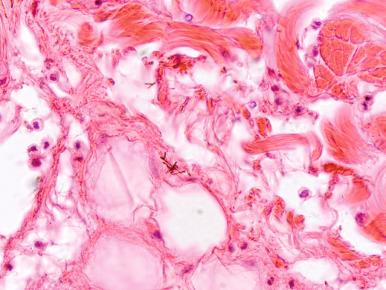
The differential diagnosis includes other infectious disorders, such as staphylococcal pyoderma, sporotrichosis, tularemia, and orf. At times, insect bites with secondary infection may resemble this lesion. The differential diagnosis of sphacelus includes the membrane of diphtheria, the eschar of ecthyma gangrenosum, tularemia, the dense crust of diabetic ulcers or ischemic ulcers associated with an arterial vasculitis, and the dark-crusted center of ulcerated lymphoma nodules.
Caused by Corynebacterium diphteriae , diphtheria was once common in the United States before being virtually eradicated by an effective immunization program that is required of almost all children and adults. Because this disease is still prevalent in some parts of the world (particularly Russia and the ex-Soviet satellites nations), the antivaccination movement gaining momentum in recent years (2009–2017) poses a tremendous threat of reemergence. Cases of cutaneous diphtheria occur in older adults and the immunosuppressed and are related to colonization of previously traumatized skin from wounds, surgery, impetigo, pyoderma, or insect bites. These lesions often present in lower limbs and hands and start as a vesicle or pustule filled with straw-colored fluid that gives rise to single or multiple punched-out ulcers (ecthyma diphtericorum), single or multiple with elevated borders. The ulcers are painful initially and then become anesthetized due to bacterial exotoxins. Similar to the lesions encountered in the pharynx and larynx, cutaneous diphtheria shows an adhering eschar (dark pseudomembrane) during the first 1 to 2 weeks. The differential diagnosis includes other lesions with a membrane (e.g., anthrax), some ischemic ulcers, and ulcers caused by vasculitis or nodular lymphomatous infiltrates, as well as the primary lesion of typhus.
The principal histopathologic change noted in cutaneous diphtheria is ulceration covered by a dense fibrin mesh containing foreign material and debris. Neutrophils may be present on the surface of the ulcer. If the diphtheria occurs secondary to another infection or lesion, evidence of the prior dermatosis will also be seen. The diagnosis is histologically confirmed by the identification of gram-positive filamentous rods of C. diphtheriae. Similar changes occur in areas of eczema or scabietic nodules that have been superinfected by the bacteria.
The virulence of C. diphteriae responds to the active secretion of the phage-induced, polypeptide-based diphtheria exotoxin. Appropriate cultures can be done only if the laboratory is alerted to the possible diagnosis and uses the appropriate medium (i.e., Löffler medium).
This disorder is a superficial infection by corynebacteria. These organisms require moist areas of the body, where they infect the stratum corneum. Thus this interesting entity is associated with the presence of characteristic patches of brown, dusky discoloration in the groin, axillae, and inframammary regions. Sometimes they also are found between the toes. There may be scaling. Other disorders that should be considered include superficial fungal infections, yeast infections, and intertrigo. A diagnostic test involving a Wood light examination reveals a characteristic coral-red fluorescence and helps to differentiate erythrasma from these other infections.
A very characteristic picture is seen in which there is virtually no host response but the changes are limited to the stratum corneum (“invisible dermatosis”). One can often see the coccobacillary and filamentous bacterial structures on H&E examination in the midst of an area of parakeratosis with a “grungy” low-power appearance ( Fig. 20.6A and B ). The bacteria are gram positive (see Fig. 20.6C ) and also stain with PAS, GMS, and Giemsa stains.

Erythrasma is associated with a variety of corynebacteria, the most common being Corynebacterium minutissimum , with rare cases being caused by Corynebacterium afermentans . These organisms are known to produce keratolytic agents that facilitate the colonization of the stratum corneum.
The appearance of yellow to white or even black and red nodules on axillary and pubic hairs is the characteristic finding of this entitiy. These concretions can be malodorous and appear to be caused by a combination of substances secreted by the organism (biofilm) and aggregation and drying of apocrine sweat. The diagnosis of this lesion is made clinically, and one can resort to a Wood lamp to show a pale yellowish fluorescence. Other concretions on the hairs include the so-called white and black piedra. Black piedra occurs on the scalp, and it is caused by Piedraia hortae . White piedra, caused by Trichosporum cutaneum , occurs on the scalp, mustache, and groin hair. These entities will be described elsewhere in this chapter.
Filamentous and coccobacillary corynebacteria are present within the nodules on the hair. They are visible with H&E but are best seen with Giemsa stain. The organisms surround the hair shaft without penetrating it, forming a sheet of organisms.
Trichobacteriosis (Trichomycosis) is caused by a variety of bacteria with the most commonly implicated organism is Corynebacterium tenuis . Production of biofilm by the organisms contributes to the formation of the lesions.
This disorder is most prevalent in young men and adolescents and particularly in individuals who are frequently barefoot. The plantar surfaces appear macerated and exhibit small (1 to 2 mm) pits, which are malodorous. It is often mistaken for a fungal infection and unsuccessfully treated as such for long periods of time. Because of the location on the feet, the maceration, and the odoriferous quality of the lesion, pitted keratolysis can usually be distinguished from pits on the palms and soles caused by Darier disease or possibly basal cell nevus syndrome.
Numerous coccobacillary and filamentous forms are found in the stratum corneum. They can be seen with H&E staining ( Fig. 20.7A ) but are best observed with Gram (see Fig. 20.7B ), PAS, GMS, or Giemsa stain. There is no host response.
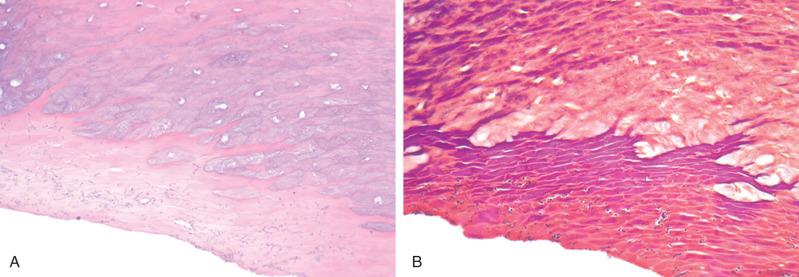
Species of Corynebacterium and other organisms, including Actinomyces spp., can result in the superficial disorder of the skin known as pitted keratolysis. Prolonged occlusion of the feet associated with heat and subsequent moisture accumulation is the background necessary for this disorder to occur. The organisms produce an enzyme that is responsible for the formation of the pits by protein digestion.
The Nocardia group, formerly classified in the Fungi kingdom, are aerobic, branching, gram-positive, weakly acid-fast bacteria that are ubiquitous and can be isolated from soil, water, and organic matter. The two most common species associated with skin involvement are Nocardia asteroides and Nocardia brasiliensis . Other clinically relevant species are Nocardia farcinica and Nocardia nova .
Human infection by microorganisms of the Nocardia genus is usually related to an immunosuppressed status, such as in patients with HIV/acquired immunodeficiency syndrome (AIDS), transplant recepients, or in those receiving immunosuppressive medications, such as corticosteroids or TNF inhibitors (infliximab). The classic route of systemic infection is via the respiratory tract (inhalation), with pulmonary infection and subsequent systemic dissemination, mainly to the central nervous system (CNS) and skin. This mechanism is usually seen in immunocompromised patients. On the other hand, immunocompetent individuals acquire cutaneous lesions through traumatic percutaneous inoculation, usually through contaminated thorns, with rare cases of infection following esthetic procedures. It is important to point out that secondary hematogenous nocardiosis skin lesions may be indistinguishable to the primary cutaneous form, so it is always important to evaluate all affected patients for pulmonary lesions.
Cutaneous involvement by Nocardia may appear clinically either as a lymphocutaneous lesion or showing chancriform or sporotrichoid morphology. In children the lymphocutaneous presentation often presents as a cervicofacial lesion. Nocardial infections can also appear forming a mycetoma, as well as other common superficial cutaneous infections, such as abscesses, ulcers, or cellulitis, the latter particularly in patients who are immunocompromised. Clear-appearing granules can be expressed from actinomycosis-like lesions. The granules' characteristics differ according to the different Nocardia and Actinomyces species ( Table 20.1 ).
| Agent | Color | Diameter (mm) | Consistency |
|---|---|---|---|
| Actinomadura madurae | White | 1.5–2 | Soft |
| Actinomadura pelletieri | Red | 0.2–0.5 | Hard |
| Nocardia brasiliensis | White or orange | <0.5 | Soft |
| Nocardia asteroides | White | <0.5 | Soft |
| Streptomyces somaliensis | Yellow | 0.5–2 | Hard |
| Madurella mycetomatis | Black | 1–2 | Hard |
Microscopically, lesions can appear as abscesses surrounded by a dense neutrophilic infiltrate, which can extend from the dermis to the subcutis and can exhibit necrosis, hemorrhage, and ulceration. A fibrous capsule surrounded by chronic inflammatory lesions is seen in chronic cases. One can also find sulfur granules, which can be indistinguishable from the ones found in actinomycosis (see later discussion). However, the granules contain bacterial forms that are positive for acid-fast staining techniques. These organisms are among the ones capable of producing eosinophilic crystalline structures in a starburst pattern, the so-called Splendore-Hoeppli phenomenon. Other less frequent presentations include pseudoepitheliomatous hyperplasia overlying an extensive mixed neutrophilic/lymphohistiocytic infiltrate ( Fig. 20.8A ) containing the filamentous organisms and an infective eccrine hidradenitis.
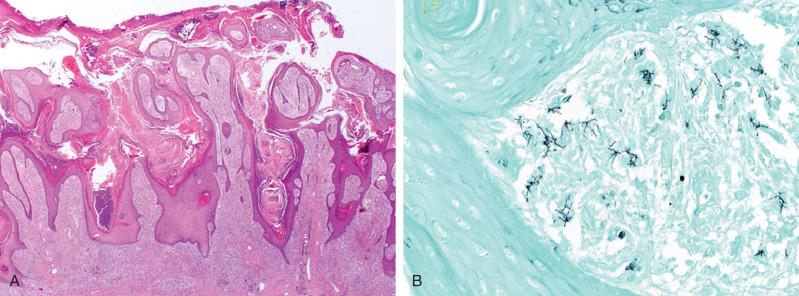
The bacteria cannot be visualized on routine H&E-stained sections. One must rely on Gram stain or acid-fast stains, which reveal fine, branched, filamentous bacteria that break up into coccobacillary forms. The silver methenamine method (GMS) is also useful to highlight the organisms (see Fig. 20.8B ). In addition, acid-fast stains are weakly positive, whereas a Fite stain usually shows stronger positivity. If organisms are not visualized morphologically, molecular methods, such as rRNA 16S sequencing or PCR-based assays, or culture can be used to identify the agent.
Organisms from the Actinomyces genus are anaerobic, nonvirulent organisms that are usually present in the oropharynx, gastrointestinal tract, and female genitalia as part of the resident microbial flora. The four clinically important species are Actinomyces israelii , Actinomyces naeslundii , Actinomyces viscosus , and Actinomyces odontolyticus . Infection by these organisms requires either a disruption of the natural barriers, from trauma or iatrogenic instrumentation, or an alteration of the normal microbial flora. The classic clinical forms are cervicofacial (55%), abdominopelvic (20%), thoracic (15%), and disseminated (10%). The disseminated form can involve multiple organs, such as the CNS, skin, pericardium, and the extremities. Infection can be found in immunocompromised individuals, such as individuals with HIV/AIDS and chronic granulomatous disease (CGD). However, the risk of actinomycosis infections is also increased in immunocompetent persons who suffer from osteonecrosis, either from bisphosphonates or radiation, as well as in women who use intrauterine devices as a method of contraception.
Cutaneous actinomycosis is a rare event and can be the product of direct inoculation, sinus tract formation from head and neck lesions, and via hematogenous seeding. Clinically the lesions show soft, painless nodules usually with multiple sinus tracts and fistulas with discharge of purulent material and so-called sulfur granules, which are represented macroscopically by firm, yellowish grains. See Table 20.1 for the characteristics of the granules produced by several Actinomyces species.
The histologic picture is dominated by the presence of abscesses and sinus tracts surrounded by granulation tissue and an outer fibrous capsule with a diffuse, mixed inflammatory infiltrate composed of foamy histiocytes, lymphocytes, and plasma cells ( Fig. 20.9A ). The sulfur granules are readily identified as discrete multilobulated granules of basophilic material, which are tangled bacterial colonies (see Fig. 20.9B ). These bodies can measure from 300 µm up to 1 to 2 mm in diameter and are surrounded by a crown of closely attached neutrophils. Sometimes, one can also see an eosinophilic, loose rim around the granules, which is known as the Splendore effect (see Fig. 20.9B ), part of the Splendore-Hoeppli phenomenon. The bacteria are highlighted by Gram stain and PAS stain with diastase, and they are negative for acid-fast stains. With the specific stains, the microorganisms are visualized as filamentous, branching mycelia that sometimes adopt a “V” shape.
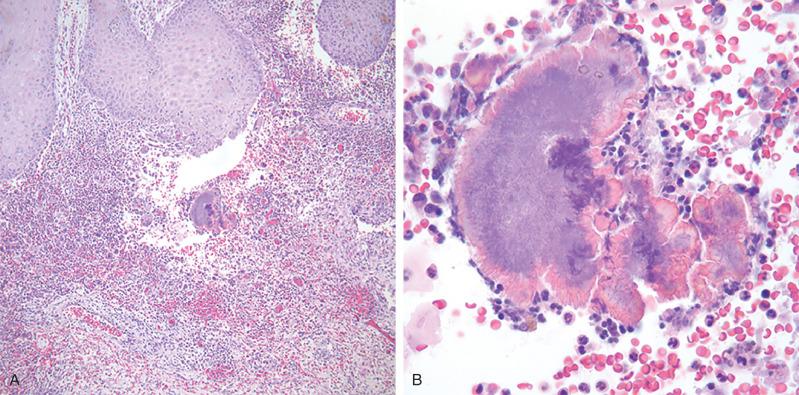
This serious infection may occur as isolated cases or in sporadic epidemics, particularly in confined spaces, such as dormitories and barracks, because the respiratory route spreads the disease. Patients who develop meningococcal septicemia are usually severely ill with high fever and exhibit a variety of skin lesions, including papules, nodules, and ecchymoses. The earliest lesions may be petechial and can lead to a correct diagnosis clinically. A devastating complication of the disease, known as the Waterhouse-Friderichsen syndrome, is associated with adrenocortical insufficiency and shock. Chronic meningococcemia is associated with recurrent episodes of fever and arthritis. Especially noteworthy is the presence of petechiae and papulopustules that occur on the lower extremities during these episodes. The acute phase of meningococcemia can resemble the effects of other infective agents, such as viruses, gonococcemia, and other gram-negative organisms. The chronic form requires ruling out other causes of necrotizing vasculitis, such as Henoch-Schönlein syndrome, Still disease, and connective tissue diseases. Evaluation with appropriate cultures is indicated.
The histopathology varies according to the stage of the disease. In patients with the fulminant form, microthrombi are almost always present in dermal vessels. At times, one can also find necrotizing vasculitis with or without thrombi and pustular thrombi. Pustular vasculitis includes an intraepidermal or intrafollicular or subepidermal abscess with extensive vasculopathy and vasculitis of vessels throughout the dermis. The picture of microthrombi with necrotizing vasculitis must always raise the possibility of a septic process as well. The chronic form of meningococcemia exhibits a relatively paucicellular type of vasculitis associated with perivascular neutrophils and lymphocytes and debris. There is also necrotizing fibrinoid necrosis. The organisms may be found in the cytoplasm of infected endothelial cells, in the neutrophils, and in extracellular locations.
Neisseria meningitides , the causative agent, can be found in the throats of a small number of asymptomatic persons who are carriers. The organism can be identified easily in patients with meningitis from the blood and spinal fluid, as well as from the skin. Bacterial wall components, such as lipopolysaccharide (LPS), are powerful endotoxins, triggering shock. The shocklike events appear to be a result of specific thrombosis of the pulmonary microvasculature. The thrombi appear to be due to the effect of toxins elaborated by the bacteria, which cause aggregation of fibrin and neutrophils. The pulmonary infection and vascular compromise result in cor pulmonale. This event does not respond to heparinization. On the other hand, another meningococcal endotoxin may result in disseminated intravascular coagulation in which one finds pure fibrin thrombi. This form of the disease is treatable by heparin. The pathogenesis of the Waterhouse-Friderichsen syndrome is usually associated with disseminated intravascular coagulation leading to vasomotor collapse. Other virulence agents include cell wall polysaccharides and proteins that evade the immune system, as well as an IgA protease.
The venereal disease called gonorrhea manifests differently in men than in women. Women most commonly have endocervicitis, whereas men develop an acute urethritis with definite painful micturition. They also can develop proctitis or oral pharyngitis. Another classic presentation of gonococcal disease includes joint involvement, exhibiting arthritis and tendonitis. After becoming septicemic, a common presentation of gonococcal septicemia includes the presence of scattered hemorrhagic pustules that are usually few in number but sometimes manifest as a folliculitis or even with bullae formation. Because the Neisseria species organisms are incapable of invading intact skin, the presence of pustules and vasculitis implies disseminated disease. Because arthritis is often present, this presentation is one of the dermatitis-arthritis syndromes. The classic gonococcal picture in the skin is a pustule surrounded by an erythematous ring associated with arthritis and tendonitis. Thus the differential diagnosis must include, importantly, Reiter syndrome because of the urethritis, as well as meningococcemia and other bacteremias.
The histopathology of the characteristic gonococcal cutaneous lesion is that of pustular vasculitis with intraepidermal subcorneal intrafollicular or subepidermal abscesses associated with diffuse vasculitis and vasculopathy throughout the dermis. Lesions that resemble cellulitis have a much more diffuse picture without vascular prominence. A simple test to confirm the diagnosis involves performing a Gram stain on a smear of one of the pustular lesions.
The causative agent, Neisseria gonorrhoeae , is known to produce agents that facilitate immune-evasion, such as the Opa and pilli type IV via antigenic variation. The pilli type IV also serves a “grappling hook” that allows the organisms to be attached to epidermal structures.
Brucellosis occurs after ingestion of contaminated food or following direct inhalation of organisms. The incubation period is usually 30 to 60 days but can be as short as 5 days. A small percentage of patients have a polymorphous rash that may include macules, eczema, a measleslike appearance, erythema multiforme (EM), or even blistering disorder and petechiae. Other symptoms include severe headache, nausea, vomiting, and possibly associated arthritis or arthropathy. There is an inoculation type of brucellosis that results in redness, papules, and pustules in workers who deal with animals, especially veterinarians.
The eczematous rash is associated with dyskeratotic cells and some extravasation of red blood cells. The EM-like rash is associated with a superficial and deep lymphohistiocytic infiltration. Inoculation brucellosis may be associated with eosinophils. Both septal and lobular panniculitis may be observed, and sometimes they are associated with necrosis.
Brucella melitensis , Brucella suis , Brucella abortus , and Brucella canis may all cause the cutaneous lesions of brucellosis. These gram-negative coccobacilli are usually found in milk or animal products. Due to their increased infectivity, these organisms are considered potential type B biologic warfare agents. Serologic diagnosis is preferred because of the long delay in culture (fastidious organism). An immunohistochemical stain specific to these bacteria is available at the CDC.
The Yersinia genus is composed of gram-negative bacilli; the medically relevant species, which are zoonotic, include Yersinia pestis , Yersinia enterocolitica , and Yersinia pseudotuberculosis . Although Y. enterocolitica and Y. pseudotuberculosis lead to yersiniosis, often showing reactive polyarthritis associated with fever, gastrointestinal symptoms and signs of erythema nodosum, Y. pestis gives rise to a frequently lethal infection known as plague. We will devote this section to the severest form of yersiniosis, plague. The normal hosts of Y. pestis are wild rodents, and their fleas act as vectors. Humans are sporadically involved when bitten by infected fleas or by contact with infected material through abrasions in the skin. A third, more severe form of involvement is the so-called pneumonic plague, which is acquired through aerosolized droplets. The latter is also the manner by which human-to-human spread of the disease is carried out. Untreated, or even with appropriate treatment, the pneumonic and septicemic forms plague are almost 100% lethal. The bubonic form, with appropriate rapid treatment, will show approximately 40% to 95% survival. Due to its tremendous virulence, this agent is considered a category A bioweapon with potential use in bioterrorism.
There are essentially three forms of plague: bubonic, pneumonic, and septicemic. All of these variants can show cutaneous involvement. The site of inoculation (flea bite) may show a pustule with subsequent ulceration, sometimes showing an ecthyma-gangrenosum–like picture. This is often followed by the development of pronounced lymphadenitis (bubo or buboes), which can sometimes fistulize to the skin, draining purulent material. An important clinical sign is that pustules or carbuncles may exhibit centrifugal vesicles around the central inflammation, usually at the site of the bite or bubo. Fever and generalized malaise are characteristic. The terminal stage of both pneumonic and cutaneous plague is the septicemic form. A primary septicemic form is also known when the port of entry is the oropharynx. Septicemic plague is characterized by generalized infection and septicemia with shock and death. Diffuse erythema is common, but one may also find petechiae and purpura with large areas of ecchymosis, changes that likely gave the denomination of “Black Plague” during the Middle Ages.
The histopathology of the various lesions depends on their clinical presentation. The site of inoculation will show nonspecific arthropod assault-related changes, sometimes with large areas of necrosis is ulceration ensues. The characteristic buboes exhibit a lymph node with edema, hemorrhage, necrosis, and clumps of bacilli represented by ground-glass amphophilic material. The bacilli will show the classic bipolar, “safety pin” gram-negative morphology by tissue Gram stain. Both Giemsa and silver impregnation histochemical stains can also be used. An immunohistochemical stain is available to highlight the bacilli. The morbilliform rash is associated with a perivenular lymphoid infiltrate. In lesions with petechiae and purpura, and especially in those associated with shock, there is usually evidence of disseminated intravascular coagulation (intravascular fibrin thrombi).
Appropriate cultures of blood and stools, throat, sputum, or aspirated fluid from buboes lead to the correct diagnosis and a Gram stain of tissue or fluid from infected sites may reveal the organisms. Serologic and molecular PCR-based assays tests are also available, predominantly at the CDC.
Like plague, tularemia is a zoonotic infection caused by a gram-negative pleomorphic coccobacillus, Francisella tularensis . This organism is one of the most virulent organisms known to humans, with fewer than 10 organisms being enough to cause an infection, in addition to being quite resistant to environmental factors. This combination of features, in a similar way to anthrax and plague, makes F. tularensis a quite dangerous agent classified as a potential category A bioweapon. The bacteria and their reservoirs, which include wild rabbits, beavers, and other rodents, are present in wilderness areas of the United States, Japan, and Russia. Vectors, such as deerflies ( Chrysops genus), ticks, and mosquitoes, as well as through contact with infected animals or their feces, transmit the disease.
Three to 5 days after inoculation, all forms of tularemia show initial symptoms of abrupt fever, rigors, and chills with accompanying headaches, generalized malaise, coryza, and sore throat. The most common clinical form of this disease is the so-called ulceroglandular presentation and is the one most frequently related with cutaneous lesions. When infection was produced from handling wild animal carcasses, the finger or hand is the first site of the inoculation, whereas in case of vector-related inoculation, it usually occurs in the lower extremities. The area of inoculation shows a rapidly growing papulonodule that later ulcerates. The ulcer tends to show “heaped-up,” irregular, overlapping borders and a necrotic/hemorrhagic base. A black eschar or sphacelus eventually develops within 3 to 5 days after contact. Other important forms of tularemia include oculoglandular, glandular, pharyngeal, typhoidal (septicemic), and pulmonary types, all with high mortality rates, especially the typhoidal and pneumonic types. In almost all forms, one tends to encounter prominent regional lymphadenitis. Culture of the organism is problematic and could result in infection of laboratory personnel; serologic diagnosis is safer and more effective. PCR-based assays are likewise diagnostic.
Ulcers will show dense fibrin necrotic debris–laden exudate overlying dermal necrosis with palisading neutrophils and suppurative granulomatous response. Likewise, the draining lymph nodes exhibit geographic areas of necrosis surrounded by palisading granulomatous inflammation with abundant neutrophils, resembling a picture seen in cat-scratch disease. The organisms are gram-negative and difficult to observe, but the Dieterle silver impregnation histochemical stain may be helpful. A specific immunohistochemical stain can highlight the organisms.
Lesions that can resemble tularemia include atypical acid-fast infections and sporotrichosis. Cat-scratch disease also must be considered in the differential diagnosis; however, the skin lesion with eschar is quite different from these other infections. The clinical history of prior contact with wild animals or their products in endemic areas is usually very helpful in the differential diagnosis.
This sexually transmitted infection, also known as donovanosis, is caused by the gram-negative coccobacillus Calymmatobacterium granulomatis , an intracellular organism closely related to the Klebsiella genus. The relationship between these two organisms is so close that some authors use the name Klebsiella granulomatis to refer to this agent. Granuloma inguinale affects communities of low socioeconomic level in tropical and subtropical areas and frequently affects individuals of African descent.
The lesions manifest as painless, often-malodorous ulcers affecting the genitalia or the anal and perianal areas that develop marked granulation tissue. These lesions spread in an unusual serpiginous pattern. Accompanying lymphadenopathy is common. Large unattended ulcers can result in prominent destruction of tissue and possible abdominal dissemination. Involvement of extragenital regions in the head and neck and trunk has been described.
The clinical differential diagnosis includes chancroid, syphilis, and lymphogranuloma venereum. Verrucous or exuberant forms of herpes simplex virus (HSV) infection can at times resemble this disorder. Lesions of granuloma inguinale can also be confused with squamous cell carcinoma (SCC).
Lesions show exuberant granulation tissue with florid reactive epidermal hyperplasia adjacent to the ulcers. Away from ulcerated areas, one may see lymphocytes and macrophages, as well as small abscesses. The abscesses are associated with macrophages up to 20 µm in diameter that contain the intracellular organisms. The organisms are 1 to 2 µm in size and exhibit a characteristic “safety pin” appearance in sections stained with Giemsa or Warthin-Starry. These intracellular structures represent the so-called Donovan bodies, originally described by Charles Donovan in 1905. There are similarities between these cells and the so-called Mikulicz cells found in rhinoscleroma, another infection caused by an organism related to the Klebsiella genus (see later).
The diagnosis can also be made via smears of tissue stained with either Giemsa or Warthin-Starry reagents. Likewise, smears made from biopsy samples may be crushed or cut into 1-µm sections and prepared for transmission electron microscopy to allow for identification of the organisms. Culture can be performed, although appropriate techniques are not widely available.
Rhinoscleroma is a rare granulomatous disorder that was described originally in central Europe, but, in the 20th and 21st centuries, most cases occur in poor areas of South and Central America, Africa, the Middle East, and Eastern Europe. The gram-negative, encapsulated, and nonmotile Klebsiella pneumoniae subsp. rhinoscleromatis is the agent causing this disease. The organisms are transmitted upon inhalation of contaminated droplets .
An overlapping sequence of three phases has been described: (1) an atrophic (rhinitic, catarrhal) stage, (2) a proliferative (hypertrophic, granulomatous) stage, and finally (3) a cicatricial (fibrous, sclerotic scarring) stage. The infection begins in the subepithelium of the nasal mucosa but can spread to the pharynx and the upper respiratory passages, including larynx and trachea. In some patients, it extends onto the lip, which is then markedly indurated with granulomatous inflammation. Involvement and destruction of other head and neck structures, such as the orbit, have been described.
The histopathologic picture of the proliferative phase of the lesion includes a prominent plasmacellular infiltrate with scattered lymphocytes and occasional neutrophils in a setting of proliferated vessels. The plasma cells characteristically bear prominent Russell bodies. Careful inspection reveals large histiocytes, measuring 10 to 100 µm in diameter, with markedly vacuolated cytoplasm, the so-called Mikulicz cells. The gram-negative K. pneumoniae subsp. rhinoscleromatis organisms populate these vacuoles and are best seen on PAS, Giemsa, or Warthin-Starry histochemical stains. They are faintly visible on H&E staining. This bacterium measures 2 to 3 µm in size, and they can be arranged in clusters within the vacuoles. The best clue to the Mikulicz cell is that it has a foamy appearance, and the bacteria can be appreciated on high-power microscopy. The cicatricial phase of the disease will show dense fibrosis and far less numerous Mikulicz cells and plasma cells. Electron microscopy likewise reveals bacilli with a filamentous coat of mucopolysaccharides, explaining the PAS positivity. On a purely histologic basis, this lesion can resemble granuloma annulare and must be differentiated from other infections and disorders that contain vacuolated macrophages, including the mycoses, Leishmania, and Hansen disease.
Chancroid is a rather common sexually transmitted disorder that may occur alone or as part of mixed infection with other venereal organisms. Mixed infections are less common in the United States but may be found in travelers returning from some developing countries. The cause of this infection is the gram-negative rod Haemophilus ducreyi . This infection is known to synergize with HSV type 2 and HIV viral infections.
The lesion of chancroid exhibits a very shallow, minimally indurated ulcer with a necrotic and dirty bed. Sometimes several ulcers are observed. The ulcers have a yellow to grayish exudate on their surface and can be exquisitely tender. Secondary tender lymphadenitis can occur unilaterally or bilaterally and sometimes can drain purulent material through fistula formation. When multiple small ulcers are present, the differential diagnosis includes infection by HSV type 2. Smears can help to differentiate these two lesions: in HSV (Tzanck test) one may find multinucleated cells, whereas in chancroid one often might see gram-negative rods in a “school of fish” pattern. The ulcer of granuloma inguinale may resemble chancroid but is nontender and does not show undermining at the margin.
The histologic picture is distinctive and essentially includes three zones of alteration. At the surface of the lesion, the exudate contains fibrin, neutrophils, neutrophilic debris, and red blood cells. The middle zone is broad and exhibits a generous granulation tissue. At times, thrombi are observed in association with focal necrosis. The third layer at the base exhibits a dense, prominent infiltrate of lymphocytes and plasma cells. However, typical zonation is not present in all cases. The bacillus is a small gram-negative coccobacillus that is approximately 1.5 µm in length and approximately 0.2 µm in width and can be seen arranged in chains amongst the cells of the surface-most portion of the lesion with Gram or Giemsa histochemical stains. Confirmation of the diagnosis by culture requires blood-enriched agar.
Malacoplakia is a rare inflammatory/infectious process that is most commonly found in the urinary tract and occasionally in the gynecologic and gastrointestinal tracts, as well as in other organs. Involvement of the skin, although rare, has been well documented in the literature. The lesion tends to arise in debilitated and immunocompromised individuals and it is thought to result from an inability of the macrophages to process bacteria. Myriad organisms, including Escherichia coli , S. aureus , Pseudomonas spp., and Proteus spp., to name a few, have been described affecting patients with malakoplakia.
The clinical presentation of malakoplakia in the skin is widely variable. Very nondescript red nodules or papules are present in the lower abdomen and the area of the groin, often around follicles. In some cases, abscesses and sinus tracks, as well as cystic or polypoid masses, may develop.
Lesions show numerous ovoid macrophages with small eccentric nuclei containing discrete eosinophilic and periodic acid–Schiff with diastase (PAS-D)-positive cytoplasmic granules that are called von Hansemann histiocytes or Hansemann cells. Some of these eosinophilic cytoplasmic granules are larger (5 to 15 µm), show a concentrically laminated pattern, and stain slightly basophilic in comparison with the other granules. They are strongly highlighted with a von Kossa histochemical stain and also stain positive with a Perls stain. These structures are the so-called Michaelis-Gutmann bodies. These bodies are composed of iron and bacterial products; they are focally calcified. Because there are portions of bacteria in the cytoplasm of the macrophages, the Gram stain can be positive focally. In addition, there is a quite striking infiltrate of lymphocytes and plasma cells amid the infiltrative macrophages. Cutaneous malakoplakia must be differentiated from fungal infections, particularly Histoplasma capsulatum , and other granulomatous inflammatory processes.
Botryomycosis is a chronic bacterial infection with deep fungal infection-like features that often affects immunosuppressed patients with diabetes mellitus, HIV/AIDS, cystic fibrosis, and other immune-dysregulating conditions. However, botryomycosis can rarely occur in an otherwise healthy individual.
This disease manifests clinically as tumors or plaques that involve the head and neck region and the extremities The lesions are often ulcerated and have discharging sinuses draining small whitish granules; hence they closely mimic mycetoma or other fungal infection. The granules are also found within the abscesses, and they can be disposed in clusters shaped as a bunch of grapes ( botrys is the Greek term for “cluster of grapes”). The causative agents are usually pyogenic, gram-positive bacteria, such as S. aureus . However, gram-negative organisms, such as P. aeruginosa , Proteus spp., and Actinobacillus spp . , have also been implicated. Culture is determinant, not only to definitely identify the agent but also to provide appropriate antibiotic therapy.
The histologic picture closely resembles that of mycetoma lesions. It is composed of an abscess cavity filled with purulent material, which contains the variably sized, irregularly shaped basophilic granules. The granules are composed of massive colonies of bacteria, which can be gram-positive or gram-negative. One can occasionally find a surrounding eosinophilic rim as part of the Splendore-Hoeppli phenomenon. Transepidermal elimination of granules can occasionally be found.
The mycobacteria can be divided into two major groups: tuberculous and nontuberculous. They can also be separated in two groups based on their culture growth (slow vs rapid growers) and biochemical characteristics. The slow growers include M. tuberculosis , Mycobacterium avium and related organisms, Mycobacterium kansasii , Mycobacterium marinum , and Mycobacterium ulcerans . The rapid growers include Mycobacterium fortuitum and Mycobacterium chelonei . Another slow grower, Mycobacterium haemophilum , has special culture requirements. Totally separate from this classification is Mycobacterium leprae because it cannot be grown in culture. The bacilli of tuberculosis and leprosy are intracellular parasites. Because they are limited to the tissues of humans and animals, they are transmitted by exposure to afflicted hosts.
The other mycobacteria are present in soil and water. The exposure of persons to these bacteria is widespread but usually is not associated with significant clinical disease. As far as staining characteristics are concerned, these organisms are weakly gram positive and are best identified by techniques that show that they are acid-fast (Fite and Ziehl-Neelsen).
M. tuberculosis infection had been well controlled for most of the second half of the 20th century in North America and Europe, but it has remained a prominent problem in resource-poor countries. During the first portion of the 21st century, there has been a surge in incidence in developed countries, mainly due to increase in migration of persons from Asia and Africa, where tuberculosis is endemic, as well as increased poverty, increased numbers of refugees from developing countries and the Middle East, and the HIV pandemic.
Although the pulmonary route of infection is the most common, M. tuberculosis can also infect the skin. There are three ways in which the skin can be affected by M. tuberculosis . First is direct inoculation, which results in a primary nodule or chancrelike lesion, a verrucous response (so-called tuberculosis verrucosa cutis ), or inoculation of the mucosae, resulting in tuberculosis cutis orificialis . Second, the infection can be spread from an internal focus, such as the lung, to the skin by a hematogenous route, which results in lesions, such as lupus vulgaris or gumma. Finally, infection can occur by direct extension from an underlying infected lymph node that has broken down and caused cutaneous ulceration. This form of tuberculosis is relatively rare in the skin and can occur (e.g., as a result of a needlestick injury) by accidental inoculation during an autopsy or a surgical procedure or even during mouth-to-mouth resuscitation.
In primary inoculation, a nodule usually appears within 2 to 4 weeks and then becomes ulcerated with an overlying crust. The draining lymph nodes become affected and may suppurate. This is the classic chancriform complex that includes an ulcerated nodule with draining lymph nodes. Often, pus can be expressed from the surface. The most common sites of involvement are the hands in adults, but in children the lesions may occur especially in the lower extremities. Tuberculosis verrucosa cutis , which occurs frequently due to needle inoculation during an autopsy, results in an isolated lesion that is verrucous and surrounded by an inflammatory border. Miliary tuberculosis describes infection of the skin by the hematogenous route; it consists of a generalized cutaneous eruption including papules and pustules a few millimeters in diameter.
Inoculated human tissues show a specific series of reactions. First, there is an acute, neutrophil-mediated infiltrate produced while the bacilli are rapidly multiplying. Next, macrophages migrate to the area and phagocytize the bacteria. As the T cells become sensitized, the tuberculous antigens result in cytokine release, which causes activation of macrophages to become epithelioid cells and giant cells. As the host delayed hypersensitivity reaction becomes stronger, necrosis of the aggregates of macrophages occurs and inactivates or indeed kills the offending organisms. A necrotic granuloma is the final picture.
The course after primary inoculation depends on a variety of factors, including the quantity of bacteria, the manner in which the infection occurred, and the patient's immune response. HIV infection or the AIDS, debilitating therapy, and immune dysregulatory drugs, particularly the new TNF inhibitors, can all affect the outcome. Histology of the primary lesion exhibits epidermal ulceration, in the base of which is fibrin and neutrophilic debris. In the dermis, depending on the age of the lesion, there may be only diffuse neutrophils, but as the delayed hypersensitivity response becomes stronger, granulomas form randomly in the dermis. Acid-fast bacilli are usually present and easily demonstrable by special stains.
In tuberculosis verrucosa cutis, there is marked epidermal hyperplasia with prominent hyperkeratosis and papillomatosis. In early lesions, dermal abscesses may be observed, but as the infection progresses, well-formed granulomas with variable necrosis are present. Miliary tuberculosis regularly exhibits a central area of abscess formation in the dermis containing neutrophils, debris, and easily visible tuberculosis bacilli.
The lesions of cutis orificialis can occur by direct inoculation of the skin or mucosa or secondarily, in patients who have extensive tuberculosis (e.g., in the bowel) and are actively excreting bacilli. Patients with disseminated tuberculosis (e.g., in the colon with lesions that are pouring bacilli into the feces) can eventually develop perianal or perineal ulcers.
A superficial ulcer is often present in association with well-formed granulomas; the lesions are profoundly necrotic and extend deep into the skin. Tubercle bacilli are easily demonstrable with appropriate stains.
The lesions of lupus vulgaris commonly occur on or adjacent to the nose and almost always in the head and neck region. The lesions consist of well-formed patches or plaques that on palpation reveal a prominent nodule. The individual lesions may vary from 1.0 mm to a few centimeters. As the lesions progress, areas of atrophy appear, while at the same time other areas may become raised or verrucous. Ulceration occurs in approximately 20% of the lesions and rarely may be associated with SCC. Scrofuloderma refers to an ulceration of the skin overlying a tuberculous lymph node or bone. The lesion, at first a nodule, becomes fistulized and ulcerated and exudes purulent material at times. Tuberculous gumma results from hematogenous spread of organisms to the skin. A large dermal and subcutaneous nodule that is partially necrotic gradually appears and can often ulcerate the skin.
Lupus vulgaris characteristically produces numerous granulomas in the upper third to upper half of the dermis, where they abut the dermal epidermal interface. Caseation necrosis is focal and sometimes absent. The granulomas contain Langhans-type giant cells. The inflammation can also extend along hair follicles into the subcutis. The overlying epidermis exhibits atrophy, alternating often with hyperplasia and papillomatosis. Occasionally, SCC can supervene in areas of hyperplasia. Tuberculous bacilli are present in very small numbers and are rarely demonstrable. Patients with this manifestation usually have very intense delayed hypersensitivity reactions to the purified protein derivative (PPD) test. Scrofuloderma produces a large cutaneous ulcer with abscesses and areas of small, well-formed but edematous granulomas with prominent necrosis. Tubercle bacilli are easily found. Tuberculous gumma exhibits massive caseation necrosis with a rim of tubercles and epithelioid cells and giant cells. There are also often lymphocytes and plasma cells admixed with the giant cells.
Pathogenesis of these lesions directly relates to the degree of immunity of the host. In the naive host, the first sign of infection is the presence of neutrophils and, as the delayed hypersensitivity reaction progresses, granulomas occur. The clinical features also reflect hypersensitivity, so that, for example, a person with a fairly established immune response will exhibit a papillary epidermal hyperplasia with a very prominent lymphogranulomatous and neutrophilic infiltrate.
There are many disorders that must be considered in the differential diagnosis because of the variety of different reactions that tuberculosis may cause. One of the most important is sarcoidosis. This disorder usually manifests with so-called naked tubercles without inflammation. However, inflammation can occur in sarcoidosis, so one must be certain of the etiology of the granuloma. Necrosis can also be seen in sarcoidosis, but it is usually fibrinoid rather than the caseating granular type seen in tuberculosis. Silica granulomas and zirconium granulomas can look very much like sarcoidosis. A polarizing light examination of the granulomatous infiltrate should always be performed to rule out a foreign body as the cause of the inflammation. Special stains, including acid-fast stain, PAS, and GMS, must also be performed to rule out other infections.
Traditional mycobacterial culture methods are frequently used to identify these agents, with the caveat of them being laborious and time consuming. Fortunately, several PCR-based assays have now been shown to be very useful in demonstrating evidence of tuberculosis bacilli in tissue with improved sensitivity and specificity.
Atypical mycobacteria are acquired by direct inoculation or by blood-borne spread from another infected site. Because these organisms are present in soil, water, and the natural environment, they are found throughout the world. In addition, the immunosuppressed states induced by HIV/AIDS, as well as by iatrogenic causes, lead to more frequent infection by these agents. In general, the histopathology of these lesions shares virtually the same spectrum as that of the tuberculosis organism. Only a few of these atypical mycobacteria are highlighted here.
The most common presentation after infection by M. kansasii is with pulmonary and nodal infections. Skin lesions are rare but can be inoculated. A resultant ulcerated nodule appears, and multiple lesions may spread along the extremity, similar to sporotrichosis.
Histologically the lesions show acute inflammation with abundant neutrophils that is associated with some granulomatous response and numerous acid-fast bacilli being highlighted with Ziehl-Neelsen or Fite. The bacilli of M. kansasii tend to be arranged haphazardly within the epithelioid cells, and they are often long and beaded, showing folds or even bended into themselves. This is in contrast to the findings usually seen in M. avium-intracellulare (MAI) complex (see next section).
MAI infection can occur in children, manifesting as a swollen cervical lymph node or as a cause of pulmonary infection in lungs that have been previously injured or damaged. The onset of the HIV/AIDS pandemic has led to rather common infections with this organism, manifesting as a variety of cutaneous papules and nodules. Generalized systemic infections with MAI (and potentially with any mycobacteria or intracellular pathogen) with involvement of the bone marrow and skin can be found in conditions that lead to a debilitated cellular immunity, such as in the X-linked inherited syndrome characterized by mutations in the IKBKG gene (Xq28) which codes the NF-kappa B essential modulator (NEMO) kinase.
The histology varies according to the immune competence of the patient. There may be an acute inflammatory response, a mixed acute and chronic inflammatory response, or a histiocytic infiltrate suggestive of lepromatous leprosy ( Fig. 20.10A ). There are also sometimes lesions that have virtually no inflammation but are teeming with organisms. The index of suspicion of possible infection with these organisms should be very high in patients with HIV/AIDS. As mentioned previously, the bacilli morphology in MAI differs from M. kansasii by the fact that the intracellular organisms in MAI are arranged orderly and somewhat parallel to each other (see Fig. 20.10B ). The bacilli themselves appear less beaded and not folded as M. kansassi bacilli. Importantly, both M. kansasii and MAI are positive with PAS, in contrast with other mycobacteria, which tend to be negative. MAI organisms tend to show a stronger reaction with PAS.
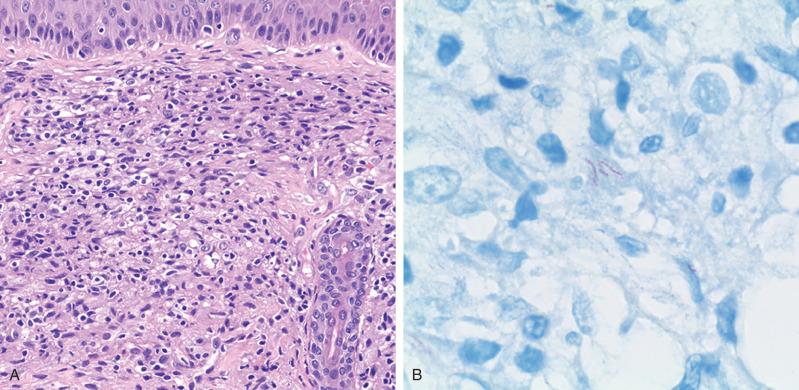
The most common cause of infection by M. marinum is trauma, typically a minor abrasion incurred while bathing in a swimming pool, lake, or the ocean. However, documented cases have occurred in patients after they cleaned an aquarium in their home. Epidemics can occur if a swimming pool is affected. Approximately 3 weeks after inoculation, reddish, hyperkeratotic, papillomatous papulonodules and plaques can occur. Ulceration is occasionally noted. Prominences of the extremities, hands, and feet are the most affected sites. Similarly to infections by other atypical mycobacteria, sporotrichosis-like spread can occur.
The changes resemble the evolution of tuberculosis infection. In the early lesions, neutrophils and macrophages are found, but, as the lesions mature, multinucleated giant cells with small granulomas are noted. In the well-formed lesion, verrucous hyperplasia can be associated with tubercle formation. Acid-fast bacilli are too difficult to observe after the very early infection. The late lesions show virtually no bacilli and must be cultured or detected by molecular biology means.
Infections by this agent result in the so-called Buruli ulcer, which is now considered a reemergent and neglected tropical infection. The lesion occurs after direct inoculation or a bite by a wide array of insects, including mosquitoes and aquatic insects, as well as by contact with infected fish. The organism is found near inland lakes and rivers, predominantly in West and Central Africa, Central America, and South Australia. Interestingly, it appears that transmission of M. ulcerans can also occur when the organisms “hitchhike” within the cytoplasm of amebas from the Acanthamoeba species. The lesion begins as a papulonodule that relatively rapidly progresses to ulceration of the skin, with resultant large subcutaneous effects that undermine the epidermis and extend into fascia and bone. The lesions are usually painless. More rarely, ulcers occur on the trunk or even on the face.
The first change results in an ischemic alteration of fat and collagen with prominent collagen necrobiosis. There are large aggregates of mycobacteria in the necrotic fat zones. Eventually, there is some neutrophilic infiltration at sites of necrosis, and the vessels exhibit thrombosis. Granulation tissue can be observed in more chronic lesions in the borders of the necrotic fat. If treatment is successful, healing results in scar formation with reepithelialization. Clumps of bacteria are present in the areas of necrosis. This unique organism has a pathogenesis related to a toxin that is a polyketide mycolactone and causes direct extensive necrosis. Healing is associated with the presence of a lymphocytic host response associated with a delayed hypersensitivity reaction. A study showed a correlation among the presence of granulomas, a high expression of interferon-γ, and prognosis. Because these organisms live best in nonoxygenated tissue, hyperbaric chamber therapy has been successful.
Cutaneous infections with unusual features caused by these rapidly growing mycobacteria have been reported. These lesions manifest as nodules in the dermis and subcutaneous fat and may have a sporotrichoid spread. They may be mistaken for erythema nodosum when on the extremities. The patients usually have some immunosuppressive feature, such as prednisone therapy or another immunodeficient state.
The dermis and subcutis exhibit mainly a suppurative inflammatory response with focal necrosis and marked karyorrhexis. Pseudocyst formation has also been noted with numerous organisms within these cystic spaces that are lined by neutrophils. There is usually little, if any, granulomatous formation. The lesions can be mistaken for a Sweet-like reaction pattern. Organisms are easily visible after staining with acid-fast stains. The Fite stain is sometimes more consistently positive. Reportedly, the organisms are characteristically focally gram positive. Culture must be performed to rule out other causes of the infection.
Leprosy, more commonly referred to now as Hansen disease, is worldwide in distribution and affects millions of people. Because the causative organism, M. leprae does not tolerate well the human core temperature of 37°C, this disease is principally one of the skin and the peripheral nerves. The disease is endemic mainly in the sub-Saharan countries in Africa, Brazil, the Indian subcontinent, and Southeast Asia. In the United States, most cases are seen in immigrants. However, native cases have been detected in Louisiana and Texas. These cases are likely related to contact with armadillos (Dasypus novemcinctus) , a known reservoir of M. leprae .
The mode of transmission in leprosy is unclear. It is hypothesized that the leprosy bacillus enters the environment contained in droplets from the nasal passages, sebum, and saliva of an infected person with limited immunity in whom it has proliferated, and then it is transmitted to other immunosuppressed individuals. Another source may be the soil. There is no evidence that skin-to-skin contact produces infection. Inhalation of the bacteria discharged into the atmosphere from an infected patient results in spread to various organs, particularly the skin and nerves, where the organism then induces a reaction. The extent of the reaction determines the course of leprosy in the patient.
The classic Ridley-Jopling classification divides leprosy in a spectrum ranging from two “poles,” tuberculoid to lepromatous, with several intermediate or “borderline/intermediate” stages. This classification is directly related with the host's immune status, with the tuberculoid form occurring in persons who have strong immunity, whereas individuals with limited/anergic immunity will present with the lepromatous variant. There is also an indeterminate form.
In the tuberculoid form, patients have intact immunity and usually exhibit a single lesion or a small cluster of lesions ( Fig. 20.11 ). Borderline leprosy is subdivided into borderline lepromatous, borderline tuberculoid, and pure borderline forms, in direct relation to the degree of possible immunity. As immunity improves, the lesions become less widespread, so that, for example, a borderline or borderline tuberculoid lesion would occur. The anergic patient has diffuse involvement of the skin, which can lead to hypopigmented or erythematous papules, macules, and plaques. The so-called leonine facies, in which there is edema of the face with loss of eyebrows and eyelashes, is an example of severe lepromatous leprosy. A variant of lepromatous leprosy is the so-called histoid leprosy, characterized by firm nodules, sometimes resembling a dermatofibroma.
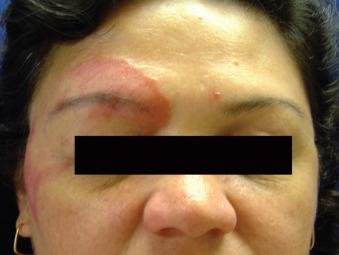
Indeterminate leprosy refers to the very earliest manifestation of the disease. It consists of a few hypopigmented macules with varying degrees of loss of sensation. Indeterminate leprosy can be associated with healing and eradication of the disease, or it can evolve into one of the subtypes of leprosy.
There are basically three types of reactions that occur in leprosy. They affect 30% to 50% of all leprosy patients and can occur both with and without treatment and are directly related to the immune status. They can be quite severe and represent medical emergencies.
In the first of the so-called type I reactions, also known as the lepra or reversal reactions, the patient has shifted during therapy from a lepromatous pattern toward a tuberculoid pattern. This change is directly related to an increase in the immune response of the patient. There is also a downgrading reaction that occurs when a patient who is not undergoing therapy progressively becomes more anergic and begins to show changes of lepromatous leprosy. These are the two manifestations of the so-called type I reaction, which can result in systemic symptoms with a change in the size of the lesions and the peripheral nerves.
The type II reactions, which are known as erythema nodosum leprosum, occur principally in borderline lepromatous patients. This type of reaction is also associated with changes in immune response and may occur with treatment or spontaneously. It is characterized by the formation of immune complexes resulting in a vasculitis or vasculopathy. The lesions evolve as very tender, red papules, plaques, and nodules that occur in normal skin.
The third type of reaction, also called Lucio phenomenon, is associated only with lepromatous leprosy. The patient develops a striking, diffuse skin edema, which tends to efface the age-related wrinkles on the face and gave rise to the historic term, “ la belle femme .” However, hemorrhagic plaques can occur suddenly on the arms, legs, and buttocks, and these eventually lead to widespread severe ulcerations.
In early indeterminate leprosy, clinically sparse lesions that are hypopigmented macules can be associated with hypoesthesia. These sometimes resemble an eczematous patch. They may disappear completely if there is eradication of the disease by the host response, or they may persist with development of one of the types of leprosy. The Mitsuda test is a delayed hypersensitivity reaction test to the lepromatous bacilli; it can help to predict the evolution of the indeterminate lesion. If the Mitsuda test is negative, the patient will usually go on to lepromatous or borderline lepromatous leprosy. If the Mitsuda test is positive, the patient will more likely develop tuberculoid leprosy or have a spontaneous remission of the lesion.
The changes can be very subtle and include a very slight lymphohistiocytic infiltrate. These cells are present particularly around neurovascular bundles and affect both superficial and deep venular plexuses, as well as the sweat glands and the arrector pili muscle. One may observe infiltration into the epidermis and may actually see lymphocytic inflammation of dermal nerves. Careful observation reveals a few acid-fast bacilli, and the diagnosis is made if the bacilli are found in the nerve or in the arrector pili muscle, just under the dermis, or in a perivascular monocyte-macrophage cell. If bacilli are not demonstrated, then the diagnosis is considered presumptive.
In lepromatous leprosy, there are diffuse lesions throughout the body. These may be macular, poorly defined, and either slightly hypopigmented or erythematous. They are frequently infiltrative, so that they become plaquelike. The most common type, the infiltrative nodular type, usually develops from a macule. These lesions are often dull red; they affect the forehead and cheeks, resulting in the leonine facies, and also affect hair follicles, resulting in loss of eyebrows and eyelashes. As the lesions progress, the nerves become involved, swollen, and very prominent. These changes are associated with some dysesthesias and nerve paralyses. The most commonly involved nerves are the ulnar, radial, and common perineal nerves.
The histopathology of the lepromatous lesion includes an extensive, diffuse cellular infiltrate. This infiltrate involves the entire dermis but is clearly separated from the epidermis by a small grenz zone of collagen ( Fig. 20.12 ). The infiltrate causes destruction of the appendages and also extends into the subcutaneous fat ( Fig. 20.13 ). The involved monocyte-macrophages exhibit a rather eosinophilic cytoplasm in which one can observe bacilli, many of which are fragmented. In these chronically persistent lesions, one can observe clumps of bacteria and bacterial fragments that are called globi.
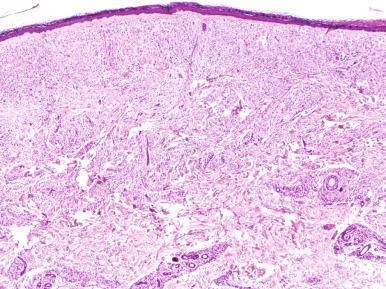
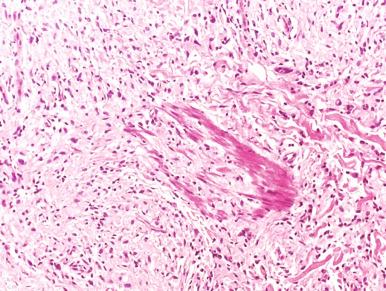
There is no evidence of any formation of epithelioid cells, and there are few lymphocytes, which are found percolating amidst the infiltrate. As the lesions persist, one can observe vacuoles in the macrophages that contain quite prominent lipid associated with fragmentation of the bacteria. The Fite stain is useful in identifying numerous mycobacteria under these circumstances ( Fig. 20.14 ). Nerves can exhibit very prominent bacilli in the lepromatous lesion. Plasma cells are frequently found in and peripheral to the infiltrate, especially in lesions in the transition to borderline lepromatous form (subpolar lepromatous leprosy) ( Fig. 20.15 ).
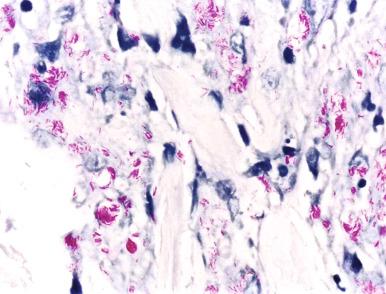
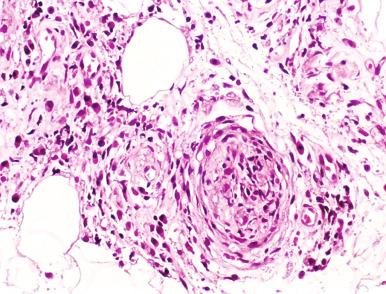
The histiod variant of lepromatous leprosy is associated with cells that have a fusiform shape and may be arranged in a storiform pattern ( Figs. 20.16 and 20.17 ). These fibrohistiocytic cells usually have a basophilic or amphophilic cytoplasm that is laden with mycobacteria, often arranged in stacks and aligning with the cell's axis ( Fig. 20.18 ).
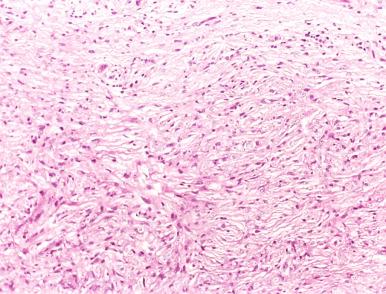
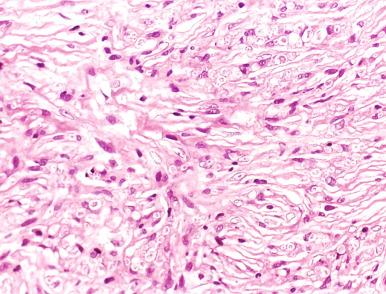
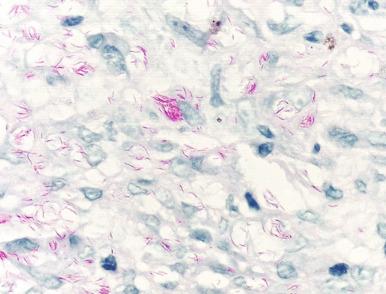
The lesions in borderline lepromatous leprosy are fewer in number and are not symmetrically disposed. They often have a central delve or dimple. The lesions vary in number according to the degree of host response. In borderline lesions with poor host response, they are more numerous. As the host response becomes stronger, fewer lesions appear and form plaques, designated as borderline tuberculoid leprosy.
In the histopathology of this lesion, there are lymphocytes and some areas of possibly very early, poor granuloma formation ( Fig. 20.19 ). Interestingly, there can be an “onionskin” appearance to some of the nerves because of perineural fibroblastic proliferation and plasma cells are present ( Fig. 20.20 ). Foamy cells are much less prominent, and one does not see globi in this form.
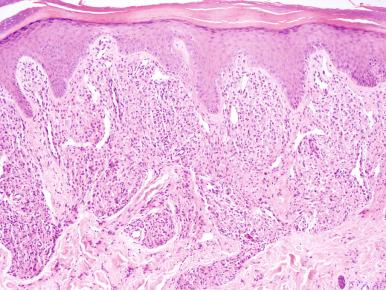
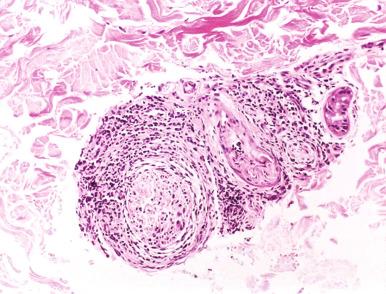
The lesions of mid-borderline leprosy are very irregularly dispersed and plaquelike but have what appear to be prominent central depressions. These lesions are also quite edematous and have been referred to as saucerlike lesions.
Histopathologically the monocyte-macrophages now begin to form epithelioid cells that are scattered but display no true granuloma formation ( Fig. 20.21 ). There are also scanty lymphocytes and scattered Langhans giant cells.
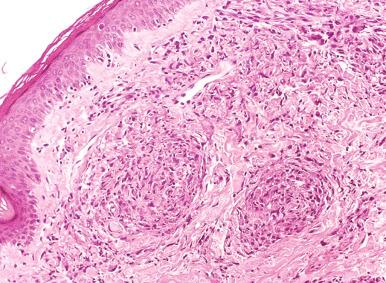
Borderline tuberculoid leprosy is associated clinically with a few scattered plaques with central hypopigmentation. These plaques are also hairless. Clinically, nerve enlargement is very marked.
The histopathology of these lesions includes granulomas associated with peripheral lymphocytes that follow along the neurovascular bundles. Occasional Langhans giant cells are noted ( Fig. 20.22 ). Accumulation of granulomas along the superficial vascular plexuses is often observed ( Fig. 20.23 ), but there is no evidence of infiltration of the epidermis itself. Bacteria are scant in number.
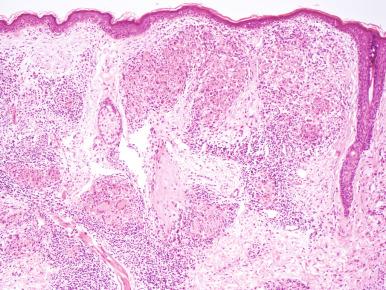
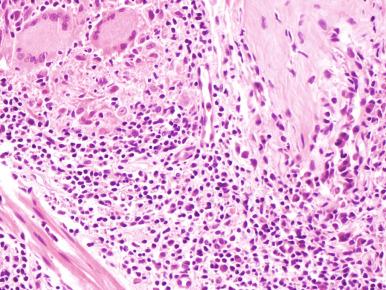
Tuberculoid leprosy is associated with the most striking immune response and manifests as very dry, scaly, hypopigmented patches or plaques with very sharply defined edges. The plaques are usually anesthetic except those on the face. The number of lesions ranges from one to five. Peripheral nerves can be very prominent.
The histopathology of this lesion exhibits true epithelioid cell granulomas following along the neurovascular bundles. Langhans giant cells can be prominent in some cases and the granulomas are associated with a dense lymphocytic cuff ( Figs. 20.24 and 20.25 ). Lymphocytic infiltration of the nerves is frequently seen ( Fig. 20.26 ). Acid-fast bacilli are rarely, if ever, found. The lesion is very similar to sarcoidosis or silicosis, except that the nerves show a very marked destructive appearance.
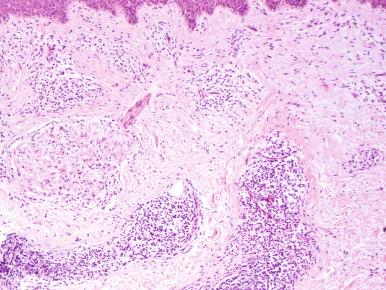
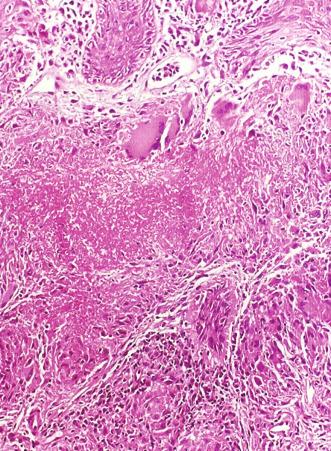
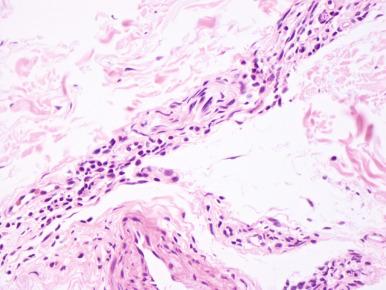
The type I reactions in leprosy have not been very well characterized. The type II reaction, erythema nodosum leprosum, clinically has some features that are more akin to EM in the reaction state; this reaction occurs only in lepromatous or borderline lepromatous patients. One can observe rather tender plaques and nodules scattered over the skin surface. There are usually marked constitutional symptoms, especially malaise and arthralgias. There are numerous neutrophils scattered in the sea of infected monocyte-macrophages, and even dermal abscesses may be noted ( Figs. 20.27 and 20.28 ). There is a perivascular infiltrate that may vary from neutrophils to neutrophils and lymphocytes with evidence of vasculitis ( Fig. 20.29 ).
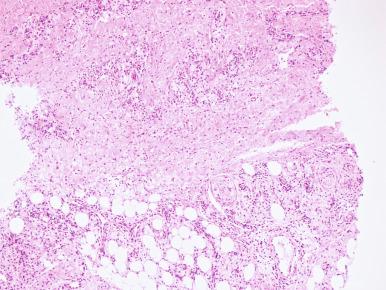
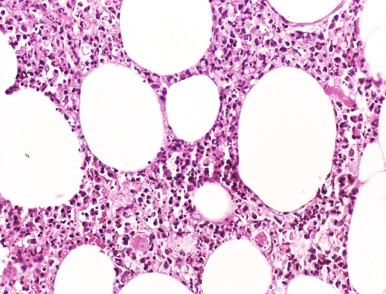
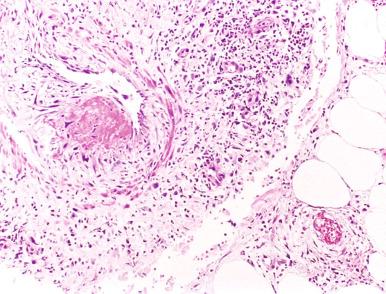
The type III or Lucio reaction is again confined to patients with lepromatous leprosy who have had no treatment or inadequate treatment. The systemic symptoms are not present, but the lesions show striking, irregularly shaped, hemorrhagic plaques that can ulcerate. The histopathology differs in that there is striking luminal obliteration of medium-sized vessels by endothelial cell proliferation, with variable thrombosis ( Fig. 20.30 ). There is a sparse lymphohistiocytic infiltrate, but acid-fast bacilli are very prominent in the walls and endothelium of normal vessels, as well as in those vessels showing the proliferative changes ( Fig. 20.31 ). The resultant ischemic necrosis leads to ulceration in many patients.
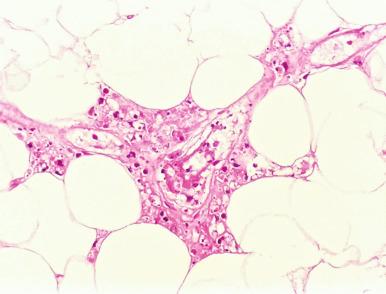
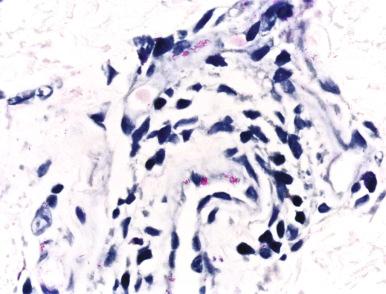
The basic pathogenetic mechanism of leprosy is a defect in T-cell activation against the mycobacteria. This failure of reaction leads to an inability of macrophages to destroy the bacilli. The specificity of the defect is demonstrated by patients with lepromatous leprosy reacting to other immunologic stimuli. Lymphocytes from lepromatous patients do not produce macrophage migration-inhibiting factor (MIF) after incubation with lepromin. On the other hand, patients with tuberculoid leprosy produce MIF after such exposure . Patients with tuberculoid leprosy have the ability to produce Th1 reactions, whereas those with lepromatous leprosy produce Th2 reactions. The Th2 reactions give rise to humoral immunity, which is ineffective against leprosy. In those patients who have either erythema nodosum leprosum or Lucio reaction, one can find IgG and C3 in the vessel walls, indicating the probable role of immune complexes in the pathogenesis of these reactions (i.e., they are apparently type III reactions).
The treponemal group consists of disorders that have been classified as venereal and nonvenereal, as reviewed in the treatise by A.N. Crowson et al. The etiologic agents are elongated, motile bacteria that belong to the Spirochaetaceae family, among which are the Treponema and Borrelia genera and the Leptospiraceae family, to which the Leptospira genus belongs.
The first recorded case of venereal treponemal infection, namely acquired syphilis (also known as lues and historically “the French disease” and the “great pox”), occurred in the 15th century, and syphilis became a dreaded disease with high mortality. High rates of mortality and morbidity continued into the 20th century, when increased public health awareness and the advent of antibiotics, especially penicillin, greatly reduced the incidence. Recently, especially with the spread of HIV, the incidence has been increasing. Transmission usually occurs by contact of an infected site with an abrasion or minor injury. Treponema pallidum , the causative agent, has a transmission rate of 10% to 60%. Yaws, pinta, and endemic syphilis are the nonvenereal treponematoses.
The primary lesion of venereal syphilis, known as chancre, appears within 21 days after exposure and manifests as a red-brown, indurated nodule or plaque 1 to 2 cm in size. It is frequently ulcerated and is painless. With the appearance of a swollen, draining lymph node, the so-called chancriform complex is complete. Lesions may appear on the tongue and be mistaken for SCC. The primary lesion may disappear spontaneously, but it always responds to appropriate therapy.
After a few weeks, a generalized eruption of reddish-brown, scaly, often oval plaques—the secondary eruption—disseminates all over the body. This eruption may resemble pityriasis rosea or psoriasis, or it can rarely be pustular. Perinasal and perioral lesions in a “split-papule” pattern are characteristic. The palms and soles are characteristically affected. Involvement of the scalp may lead to “moth-eaten” alopecia. Involvement of the anogenital or axillary areas can result in a confluence of papillomatous papules (e.g., in perianal array). These lesions are known as condyloma lata. In late secondary lues the eruption may have a serpiginous appearance and can appear as annular lesions. These lesions, if left untreated, may persist for some time or recur, as may partially treated syphilis. A particular clinical form of secondary syphilis is the so-called malignant, ulcernodular, or rupioid syphilis, which is characterized by multiple pleomorphic round to oval papules, papulopustules, or nodules with ulceration, without central clearing, and additionally exhibiting a “rupioid,” oysterlike lamellated brown to black crust ( Fig. 20.32 ). These lesions have a propensity to arise in the head and neck region, and they are often accompanied by constitutional symptoms. This particular presentation of lues was vanishingly rare until the onset of the HIV/AIDS epidemic, after which it has been reported with more frequency. In keeping with the “great imitator” moniker, this form of syphilis can easily mimic cutaneous lymphoma, sometimes even showing positive TCR rearrangement studies. Treponemal fluorescent serologic studies are positive in almost 100% of cases.
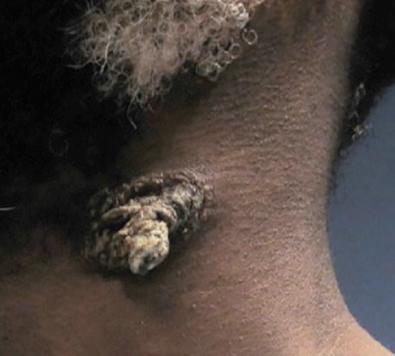
The tertiary phase appears after the primary and secondary phases go into a latency period, or latent phase, which has been defined by the CDC to be early if present for less than 1 year or late if present for more than 1 year. The World Health Organization (WHO) uses 2 years as the cutoff between early and late latent phase. Meningovascular syphilis can occur during the late secondary phase or in the tertiary phase. The other manifestations include skin nodules and cardiovascular and neurologic disorders. The skin and mucosal lesions are nodules referred to as gummas.
Congenital syphilis should be suspected in the child born of a mother with active or inadequately treated syphilis, or in the event of a reactive serologic test for syphilis, a positive test of the cerebrospinal fluid, elevated cerebrospinal fluid protein, or an elevated white blood cell count of unknown cause. The clinical features of the early form include the so-called snuffles or rhinitis, hepatosplenomegaly, or a widely disseminated rash of unknown cause. The late phase exhibits, among other features, the classic Hutchinson triad: notched incisors teeth (Hutchinson teeth), keratitis, and deafness. Transplacental infection occurs and is more common in mothers with secondary syphilis (approximately 50%) and less common in mothers with early (40%) or late (10%) latent syphilis.
Two very important histologic observations, common to all forms of syphilis, are: (1) the presence of endothelial swelling, often with obliteration of the vessel lumen, and (2) the presence of a perivascular lymphocytic and plasmacellular infiltrate.
The hallmark of the primary phase of the disease, the syphilitic chancre, often exhibits a markedly hyperplastic epidermis that is frequently ulcerated. Beneath the epidermis is a dense infiltrate of mainly lymphocytes and plasma cells with scattered histiocytic mononuclear cells. A striking endarteritis obliterans is present, with the lymphoid cells and plasma cells infiltrating the walls of the vessels. Spirochetes can be identified with appropriate silver stains (Warthin-Starry or Steiner) or by electron microscopy. When fresh material is obtained from the chancre, organisms can be seen by darkfield microscopic examination. T. pallidum , the causative organism, is 8 to 16 µm in length and 0.10 to 0.18 µm in width and is seen between the keratinocytes, at the basement membrane zone, and in the dermis in perivascular array. The infiltrate is so dense and activated that lymphoma is sometimes considered in differential diagnosis. The regional lymph nodes draining the chancre area can exhibit reactive changes, with numerous plasma cells associated with follicular hyperplasia. Prominent endothelial cell changes can be seen, which are similar to the ones seen in the skin, discussed previously. Poorly formed granulomas may occasionally be observed. Spirochetes are plentiful and can be seen with proper staining. Because silver impregnation histochemical stains are notorious for being difficult to interpret, the development of much more sensitive and specific immunohistochemical stains has been more than welcomed.
The main differential diagnosis of cutaneous primary syphilis is chancroid, caused by H. ducreyi . However, in that disorder, the ulcer shows characteristic zonation: a superficial area with acute inflammation, a middle layer with numerous proliferating capillaries, and a lymphoplasmacellular infiltrate at the base. Giemsa staining reveals the numerous coccobacillary forms between keratinocytes and along the basement membrane zone (see later for an at length discussion of this entity).
Cutaneous lesions in secondary syphilis often show epidermal hyperplasia, which is often psoriasiform, overlying a bandlike infiltrate of lymphocytes and plasma cells ( Fig. 20.33 ). There may be rare neutrophils with debris. Lichenoid/interface change is often seen with apoptotic keratinocytes present at the basal layer. Organisms can be quite numerous and are easily identified in the epidermis with the help of immunohistochemical stains ( Fig. 20.34 ). Often, there are characteristically thin rete ridges in an “icepick” configuration. Beneath is a superficial and deep perivascular infiltrate with mononuclear cells that form almost granuloma-like aggregates. Endothelial swelling is prominent and may in part lead to the granulomatous appearance. However, in some cases the infiltrate is focal and slight, and the endothelial swelling is the clue to the diagnosis in the presence of the plasma cells. In other cases the infiltrate may be so dense and associated with activated lymphoid cells as to suggest mycosis fungoides.
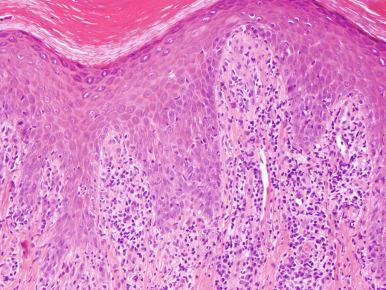
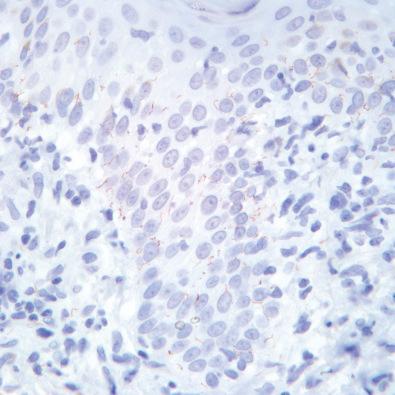
In late stages of secondary syphilis, granulomas are invariably present and may even suggest sarcoidosis. In 25% to 40% of early secondary syphilis, lymphocytes predominate, with the plasma cells entering later. As far as vascular changes are concerned, one may find fibrinoid necrosis in some cases of syphilis, especially in so-called lues maligna, in which thrombotic vasculitic changes maybe present. Other features seen in malignant syphilis include pseudoepitheliomatous epidermal hyperplasia, ill-formed granulomas, and interface change.
With regard to luetic alopecia, the hair follicles tend to show plugging, bulbar infiltration by lymphocytes and plasma cells, and perifollicular fibrosis. Both a lichenoid and perivascular lymphoplasmacellular infiltrate are also noted.
Nodular tertiary syphilis exhibits small nodules with scattered giant cells, rare granulomas, and scattered lymphocytes and plasma cells. In gummatous tertiary syphilis, there is quite prominent necrosis that is acellular. It is associated with striking plasmacellular vascular changes that extend into the dermis.
As the host's immune response becomes more and more exuberant with the evolution of the disease, in both late secondary syphilis and in the tertiary form, organisms become increasingly difficult to identify. In late secondary lues, appropriate silver stains demonstrate the spirochete in approximately one-third of cases, best visualized in the epidermis. Even with the help of T. pallidum immunohistochemistry, the chances of identifying the organisms in tissue are markedly reduced in this phase of the disease, often requiring examination of multiple tissue levels.
Yaws, also known as frambesia tropica , thymosis, or polypapilloma tropicum , is a tropical infection caused by T. pallidum subsp. pertenue , a subspecies of T. pallidum . T. pallidum pertenue is differentiated from T. pallidum by substitution of a single nucleotide in its DNA. Yaws is spread by skin-to-skin contact in a nonvenereal fashion. It is found predominantly in warm climates, such as the hot, humid areas of South America, Africa, Southeast Asia, and Oceania.
The site of inoculation often shows an area of erythema and involves usually the lower limbs. Approximately 15 to 21 days after inoculation, a nodule appears at the site; it enlarges centrifugally to a lesion 1 to 5 cm in size, with a reddish, crusted appearance, surrounded by pustules. The lesion is said to resemble a raspberry and therefore has been dubbed “frambesiform.” Lesions can spontaneously disappear and leave a scar after 3 to 6 months. Fever and constitutional symptoms may be present. Weeks or months later, the secondary phase of the disease ensues with affectation of skin and bones. Constitutional symptoms and generalized lymphadenopathy are seen. Cutaneous lesions are represented by the onset of a widespread eruption of smaller lesions that have been designated “daughter yaws” due to their resemblance to the primary lesion. The lesions can be annular and thereby resemble syphilis, and they can, in the same way as syphilis, affect the axillae and groin areas. These annular lesions can appear in the orofacial area. Pustular lesions may be noted. Hyperkeratotic lesions also can occur on both hands and feet; when present on the feet, they result in an awkward crablike waddling gait known as “yaws gait” or “crab yaws.” Lesions can recur for up to 5 years and affect mainly the perioral areas and the axillae. Secondary bone lesions may result in periosteal nodules and thickening.
Tertiary yaws occurs in approximately 10% of cases and in the skin produces nodules, ulcers, and serpiginous tracts, as well as scars and keloids. In some cases, there is keratoderma and even palmar-plantar hyperkeratosis. Involvement of other organs is characteristic. The bone and joint lesions can include osteomyelitis and sometimes hypertrophic periostitis; chronic tibial disease can give rise to “saber shin.” The facial bones can be involved with bilateral hypertrophy of the nasal component of the maxilla, an obstructive lesion known as “goundou.” The tertiary phase of yaws can also give rise to rhinopharyngitis mutilans, also called “gangosa,” which is characterized by ulceration and destruction of the nasal septum, palate, and surrounding bone and soft tissue, often leaving disfiguring, mutilating scars. These complications can all be averted by proper antibiotic therapy.
The primary lesion exhibits hyperplasia of the epidermis with intercellular edema and intraepidermal abscesses with focal papillomatosis. In the dermis, there is a striking infiltrate of lymphoid cells, with histiocytes and plasma cells and scattered neutrophils and eosinophils. The prominent vascular change seen in syphilis is not present. The secondary form is associated with epidermal hyperplasia and papillomatosis, and the infiltrate is again diffuse without vasculopathy. The tertiary yaws cutaneous lesions resemble the ulcerative granulomatous lesions of syphilis.
One can demonstrate the organisms by darkfield microscopy from material obtained from lesions in the first two phases of the disease. On histologic samples, silver stains, such as Warthin-Starry, will reveal the organisms to be present between keratinocytes, but they do not appear in the dermis. Developments of molecular PCR-based assays appear to be promising new tools that will aid the diagnosis of yaws and the other nonvenereal treponemal diseases.
Pinta is the only treponemal condition that affects only the skin. The disease occurs endemically in hot, humid areas of Central and South America and is not found outside the Western Hemisphere. It is caused by T. pallidum subsp. carateum . Transmission is also by skin-to-skin contact, often among family members.
This disease is limited to the skin, and its manifestations are predominantly associated with abnormalities of pigmentation. The primary lesion often appears in the lower limbs and is represented by a small, scaly, reddish to reddish-brown papule that is very pruritic and is surrounded by a halo. The lesion gradually spreads and may reach a size of 10 to 12 cm with a psoriasiform or eczematous appearance. Ulceration is not a feature of primary pinta.
The secondary lesions, called pintids, are small, scaly papules that coalesce into psoriasiform plaques. Both the primary and secondary lesions are highly infectious. The third stage consists of hypopigmentation over the ankles, wrists, knees, and elbows. These areas are mixed with areas of hyperpigmented or hypopigmented skin. The hypopigmentation is often symmetric and, in late achromic stages, has a stockinglike or glovelike appearance. Both atrophic and hyperkeratotic areas may be present in a given lesion.
Histologically, irregular epidermal hyperplasia with a sparse infiltrate of lymphocytes, plasma cells, and neutrophils around dilated vessels is characteristic of both the first and second stages, with melanophages more prominent in the second stage. In the third stage, there is either marked hyperpigmentation with numerous melanophages or profound depigmentation with a scattered lymphocytic and plasma cellular infiltration. The organisms are present in all but the very late tertiary-stage hypopigmented lesions.
Endemic syphilis, also known as bejel , belesh , or bishel in Arab countries and as dichuchwa and njovera in African countries, is another disease caused by a T. pallidum subspecies, namely T. pallidum subsp. endemicum . This particular organism is also limited in its geographic location, to the southern border of the Sahara Desert and the Arabian Peninsula. Transmission is produced via skin-to-skin contact and affects mainly children up to 15 years of age. It is also known to spread by common use of pipes or drinking cups.
The primary lesions are rarely identified and sometimes manifest as papules or ulcerated lesions of the oropharynx. Rarely, an infected infant can give the disease to a nursing mother, with a resultant nipple lesion occurring.
On the other hand, secondary lesions are common and may be the first sign of the disease. Small, painless papules and shallow ulcers appear on the lips, mouth, pharynx, and even larynx, with resultant hoarseness. Regional adenopathy is common. Less commonly, one can find condyloma lata–like lesions in the axillae and the groin.
The tertiary phase can manifest as gummatous lesions that form ulcers that scar and affect skin, nasopharynx, larynx, and bone. The bony lesions can greatly resemble those of yaws, in which one can find marked periosteal thickening. In addition, there can be perforation of the nasopharynx or the palate.
The histology of the lesions appears to be similar to what one would find in venereal syphilis. Early lesions show a dermal perivascular inflammatory infiltrate composed of lymphocytes and plasma cells. Granulomas may be present. Lesions in the late, ulcerated stage show epidermal and epithelial hyperplasia with a loosely arrayed lymphohistiocytic and plasmacellular infiltrate. Spirochetes are present in the early lesions, with prominent intraepidermal involvement.
Lyme disease derives its name from the city of Lyme, Connecticut, where the first epidemic of the disease was described. The lesion is caused by the spirochete Borrelia burgdorferi , which is primarily transmitted by the tick Ixodes dammini (deer tick). Other soft ticks of the Ornithodoros genus have also been implicated. The disease has been identified in up to 32 states in the United States, as well as elsewhere in the world, including in Europe, Africa, and Asia.
Become a Clinical Tree membership for Full access and enjoy Unlimited articles
If you are a member. Log in here